Influence of Social Media on Consumer Holiday Decision-Making in Travel & Tourism
VerifiedAdded on 2024/05/29
|35
|5903
|193
AI Summary
This research explores the impact of social media on consumer holiday decision-making in the travel and tourism sector. It investigates how social media platforms like Facebook influence travellers' choices, planning processes, and overall holiday experiences. The study utilizes a combination of primary and secondary research methods, including a structured online questionnaire and a comprehensive literature review. The findings reveal that social media plays a significant role in shaping consumer decisions, with factors like user reviews, recommendations, and visual content heavily influencing holiday planning. The research highlights the importance of social media marketing for travel and tourism businesses and provides insights into how to effectively leverage these platforms to attract and engage potential customers.
Contribute Materials
Your contribution can guide someone’s learning journey. Share your
documents today.

UNIT 4 RESEARCH PROJECT
‘Influence of social media on consumer’s holiday decision-making process in
the travel and tourism sector’.
1
‘Influence of social media on consumer’s holiday decision-making process in
the travel and tourism sector’.
1
Secure Best Marks with AI Grader
Need help grading? Try our AI Grader for instant feedback on your assignments.
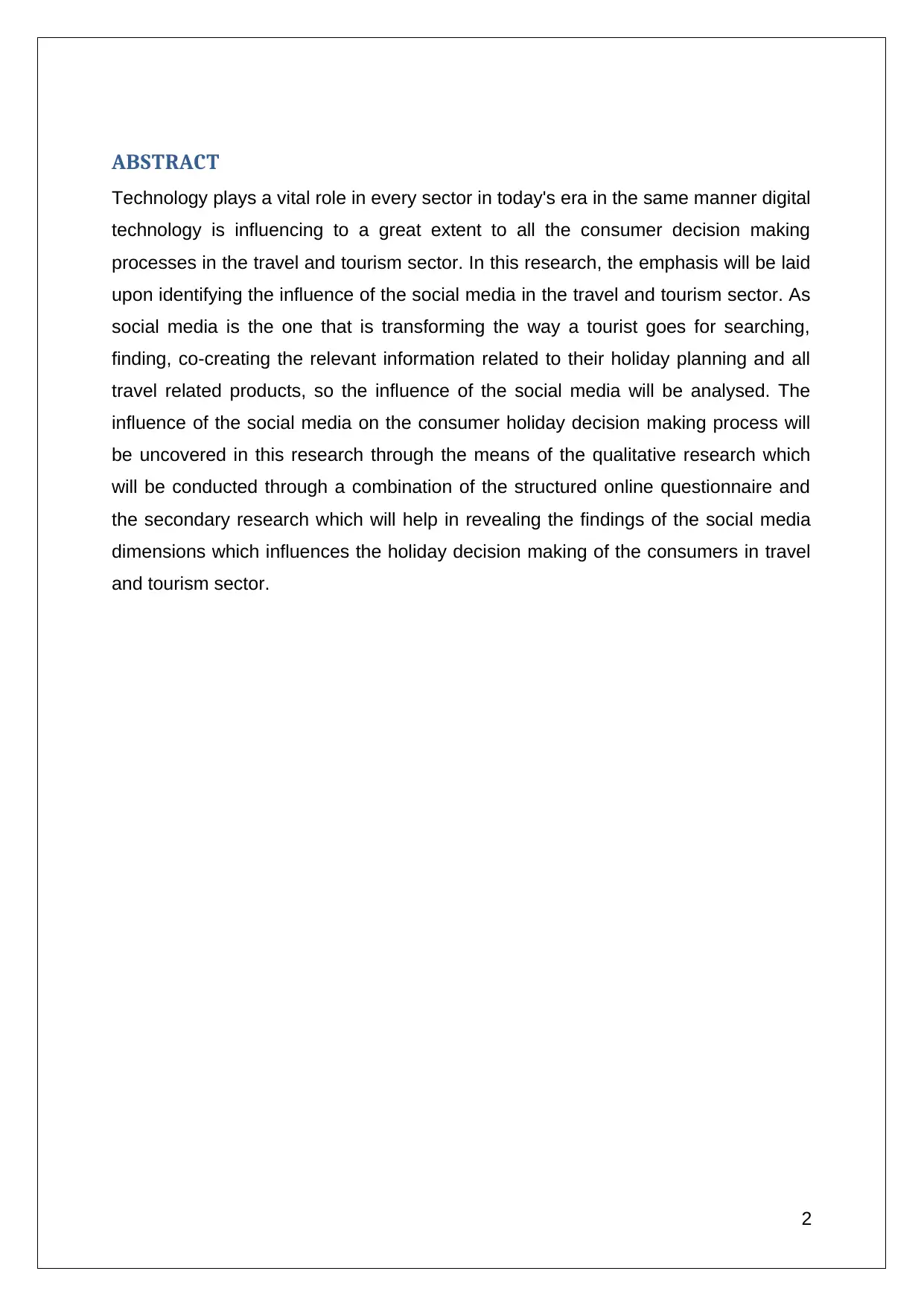
ABSTRACT
Technology plays a vital role in every sector in today's era in the same manner digital
technology is influencing to a great extent to all the consumer decision making
processes in the travel and tourism sector. In this research, the emphasis will be laid
upon identifying the influence of the social media in the travel and tourism sector. As
social media is the one that is transforming the way a tourist goes for searching,
finding, co-creating the relevant information related to their holiday planning and all
travel related products, so the influence of the social media will be analysed. The
influence of the social media on the consumer holiday decision making process will
be uncovered in this research through the means of the qualitative research which
will be conducted through a combination of the structured online questionnaire and
the secondary research which will help in revealing the findings of the social media
dimensions which influences the holiday decision making of the consumers in travel
and tourism sector.
2
Technology plays a vital role in every sector in today's era in the same manner digital
technology is influencing to a great extent to all the consumer decision making
processes in the travel and tourism sector. In this research, the emphasis will be laid
upon identifying the influence of the social media in the travel and tourism sector. As
social media is the one that is transforming the way a tourist goes for searching,
finding, co-creating the relevant information related to their holiday planning and all
travel related products, so the influence of the social media will be analysed. The
influence of the social media on the consumer holiday decision making process will
be uncovered in this research through the means of the qualitative research which
will be conducted through a combination of the structured online questionnaire and
the secondary research which will help in revealing the findings of the social media
dimensions which influences the holiday decision making of the consumers in travel
and tourism sector.
2
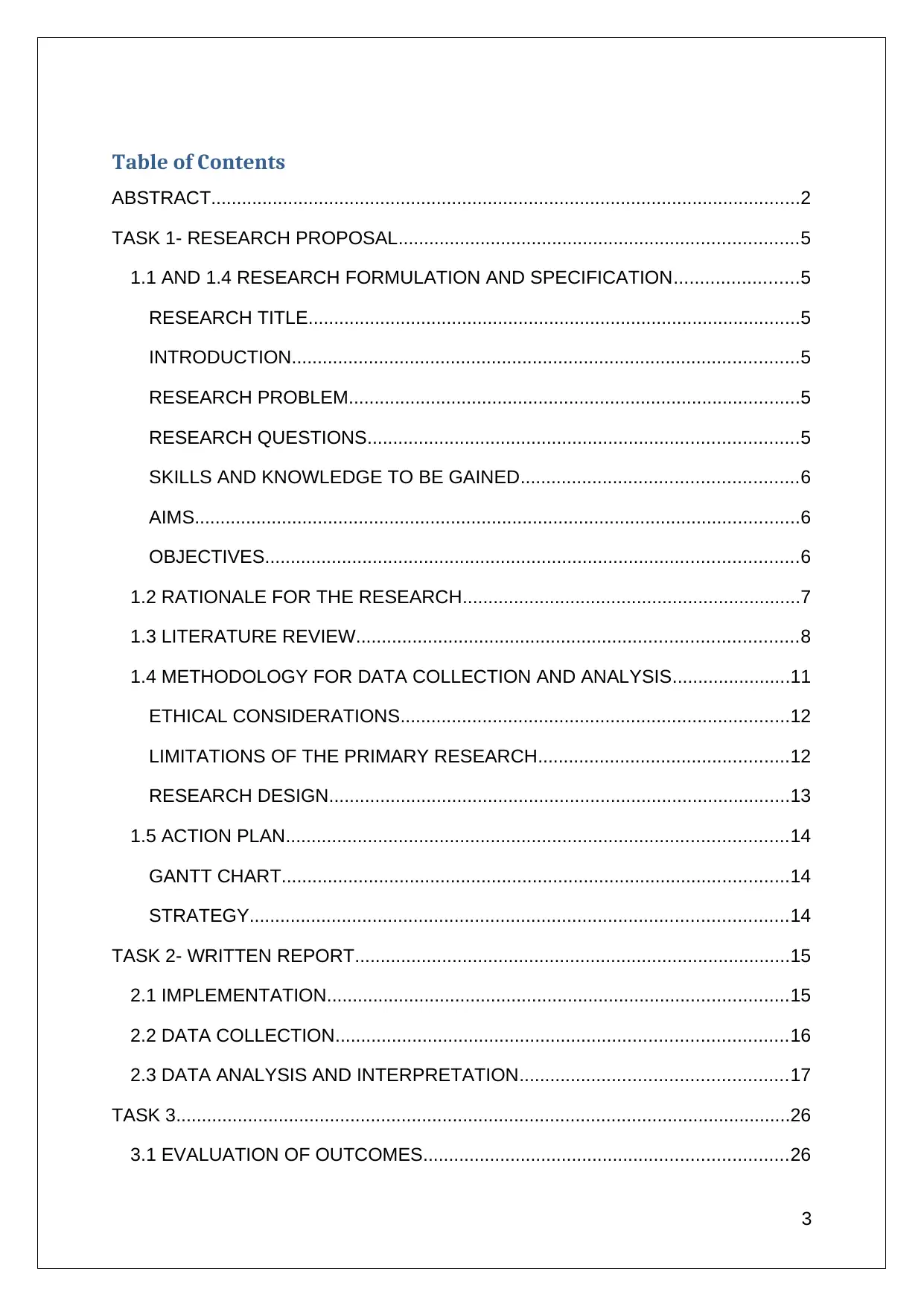
Table of Contents
ABSTRACT...................................................................................................................2
TASK 1- RESEARCH PROPOSAL..............................................................................5
1.1 AND 1.4 RESEARCH FORMULATION AND SPECIFICATION........................5
RESEARCH TITLE................................................................................................5
INTRODUCTION...................................................................................................5
RESEARCH PROBLEM........................................................................................5
RESEARCH QUESTIONS....................................................................................5
SKILLS AND KNOWLEDGE TO BE GAINED......................................................6
AIMS......................................................................................................................6
OBJECTIVES........................................................................................................6
1.2 RATIONALE FOR THE RESEARCH..................................................................7
1.3 LITERATURE REVIEW......................................................................................8
1.4 METHODOLOGY FOR DATA COLLECTION AND ANALYSIS.......................11
ETHICAL CONSIDERATIONS............................................................................12
LIMITATIONS OF THE PRIMARY RESEARCH.................................................12
RESEARCH DESIGN..........................................................................................13
1.5 ACTION PLAN..................................................................................................14
GANTT CHART...................................................................................................14
STRATEGY.........................................................................................................14
TASK 2- WRITTEN REPORT.....................................................................................15
2.1 IMPLEMENTATION..........................................................................................15
2.2 DATA COLLECTION........................................................................................16
2.3 DATA ANALYSIS AND INTERPRETATION....................................................17
TASK 3........................................................................................................................26
3.1 EVALUATION OF OUTCOMES.......................................................................26
3
ABSTRACT...................................................................................................................2
TASK 1- RESEARCH PROPOSAL..............................................................................5
1.1 AND 1.4 RESEARCH FORMULATION AND SPECIFICATION........................5
RESEARCH TITLE................................................................................................5
INTRODUCTION...................................................................................................5
RESEARCH PROBLEM........................................................................................5
RESEARCH QUESTIONS....................................................................................5
SKILLS AND KNOWLEDGE TO BE GAINED......................................................6
AIMS......................................................................................................................6
OBJECTIVES........................................................................................................6
1.2 RATIONALE FOR THE RESEARCH..................................................................7
1.3 LITERATURE REVIEW......................................................................................8
1.4 METHODOLOGY FOR DATA COLLECTION AND ANALYSIS.......................11
ETHICAL CONSIDERATIONS............................................................................12
LIMITATIONS OF THE PRIMARY RESEARCH.................................................12
RESEARCH DESIGN..........................................................................................13
1.5 ACTION PLAN..................................................................................................14
GANTT CHART...................................................................................................14
STRATEGY.........................................................................................................14
TASK 2- WRITTEN REPORT.....................................................................................15
2.1 IMPLEMENTATION..........................................................................................15
2.2 DATA COLLECTION........................................................................................16
2.3 DATA ANALYSIS AND INTERPRETATION....................................................17
TASK 3........................................................................................................................26
3.1 EVALUATION OF OUTCOMES.......................................................................26
3
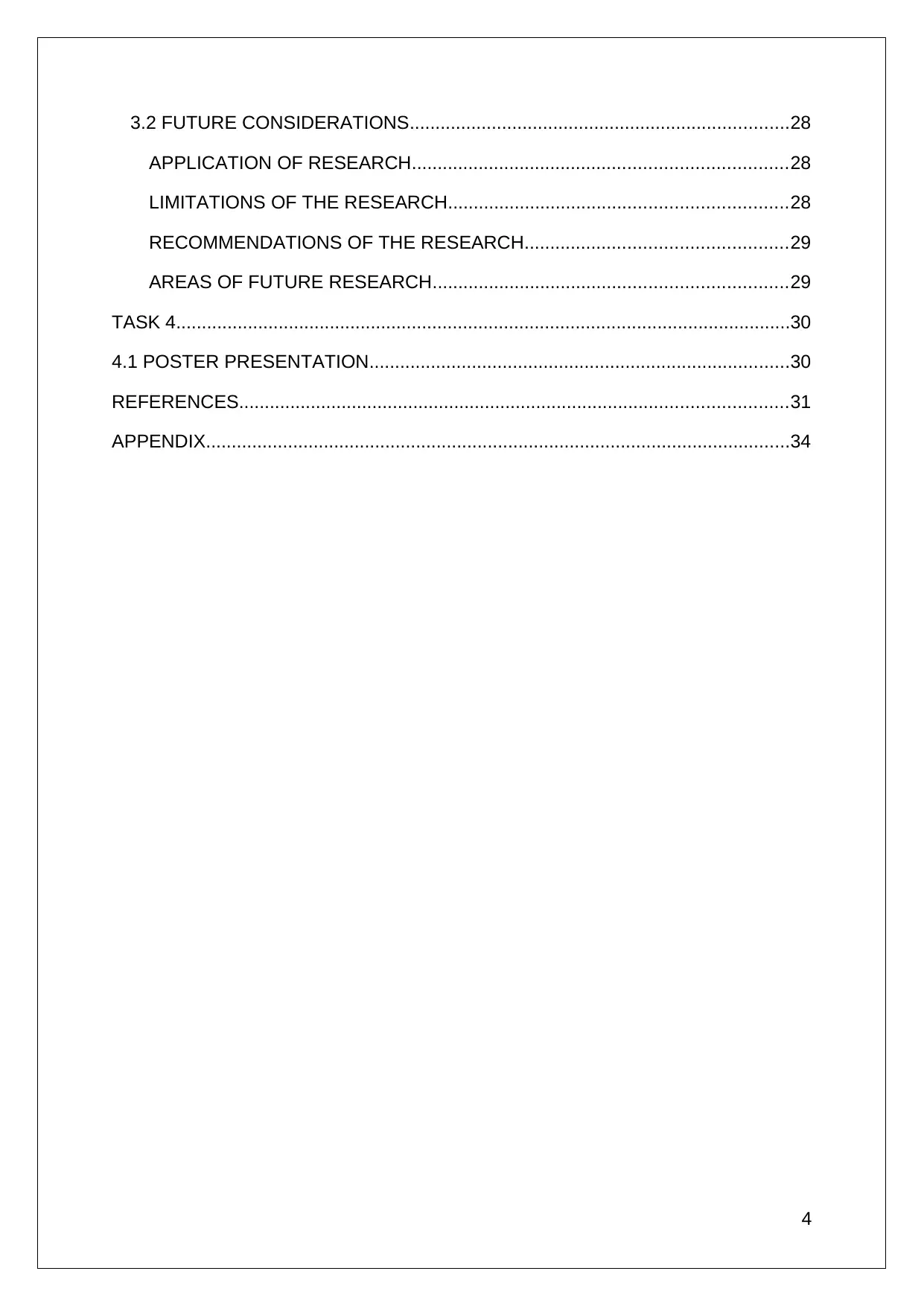
3.2 FUTURE CONSIDERATIONS..........................................................................28
APPLICATION OF RESEARCH.........................................................................28
LIMITATIONS OF THE RESEARCH..................................................................28
RECOMMENDATIONS OF THE RESEARCH...................................................29
AREAS OF FUTURE RESEARCH.....................................................................29
TASK 4........................................................................................................................30
4.1 POSTER PRESENTATION..................................................................................30
REFERENCES...........................................................................................................31
APPENDIX..................................................................................................................34
4
APPLICATION OF RESEARCH.........................................................................28
LIMITATIONS OF THE RESEARCH..................................................................28
RECOMMENDATIONS OF THE RESEARCH...................................................29
AREAS OF FUTURE RESEARCH.....................................................................29
TASK 4........................................................................................................................30
4.1 POSTER PRESENTATION..................................................................................30
REFERENCES...........................................................................................................31
APPENDIX..................................................................................................................34
4
Secure Best Marks with AI Grader
Need help grading? Try our AI Grader for instant feedback on your assignments.
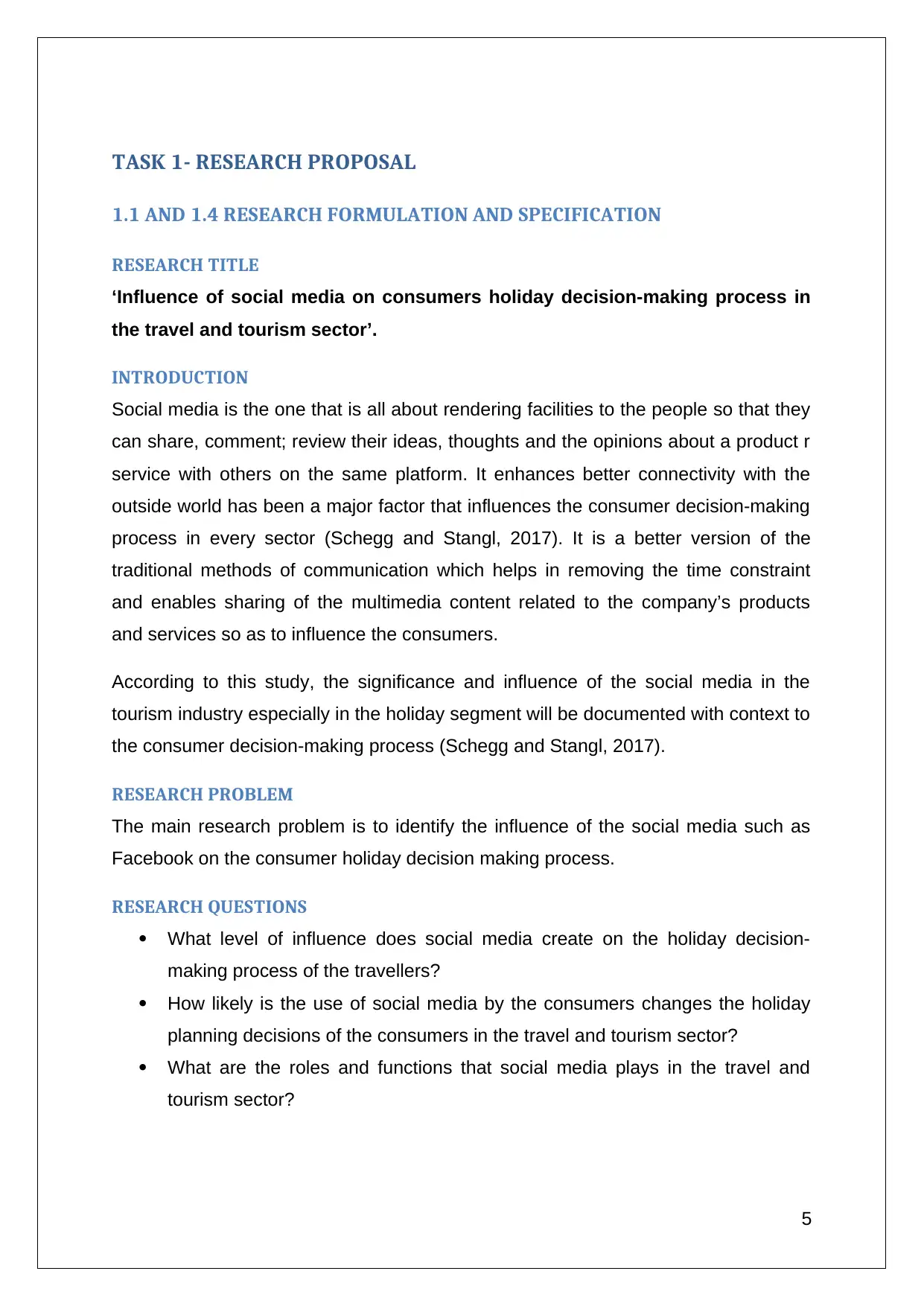
TASK 1- RESEARCH PROPOSAL
1.1 AND 1.4 RESEARCH FORMULATION AND SPECIFICATION
RESEARCH TITLE
‘Influence of social media on consumers holiday decision-making process in
the travel and tourism sector’.
INTRODUCTION
Social media is the one that is all about rendering facilities to the people so that they
can share, comment; review their ideas, thoughts and the opinions about a product r
service with others on the same platform. It enhances better connectivity with the
outside world has been a major factor that influences the consumer decision-making
process in every sector (Schegg and Stangl, 2017). It is a better version of the
traditional methods of communication which helps in removing the time constraint
and enables sharing of the multimedia content related to the company’s products
and services so as to influence the consumers.
According to this study, the significance and influence of the social media in the
tourism industry especially in the holiday segment will be documented with context to
the consumer decision-making process (Schegg and Stangl, 2017).
RESEARCH PROBLEM
The main research problem is to identify the influence of the social media such as
Facebook on the consumer holiday decision making process.
RESEARCH QUESTIONS
What level of influence does social media create on the holiday decision-
making process of the travellers?
How likely is the use of social media by the consumers changes the holiday
planning decisions of the consumers in the travel and tourism sector?
What are the roles and functions that social media plays in the travel and
tourism sector?
5
1.1 AND 1.4 RESEARCH FORMULATION AND SPECIFICATION
RESEARCH TITLE
‘Influence of social media on consumers holiday decision-making process in
the travel and tourism sector’.
INTRODUCTION
Social media is the one that is all about rendering facilities to the people so that they
can share, comment; review their ideas, thoughts and the opinions about a product r
service with others on the same platform. It enhances better connectivity with the
outside world has been a major factor that influences the consumer decision-making
process in every sector (Schegg and Stangl, 2017). It is a better version of the
traditional methods of communication which helps in removing the time constraint
and enables sharing of the multimedia content related to the company’s products
and services so as to influence the consumers.
According to this study, the significance and influence of the social media in the
tourism industry especially in the holiday segment will be documented with context to
the consumer decision-making process (Schegg and Stangl, 2017).
RESEARCH PROBLEM
The main research problem is to identify the influence of the social media such as
Facebook on the consumer holiday decision making process.
RESEARCH QUESTIONS
What level of influence does social media create on the holiday decision-
making process of the travellers?
How likely is the use of social media by the consumers changes the holiday
planning decisions of the consumers in the travel and tourism sector?
What are the roles and functions that social media plays in the travel and
tourism sector?
5
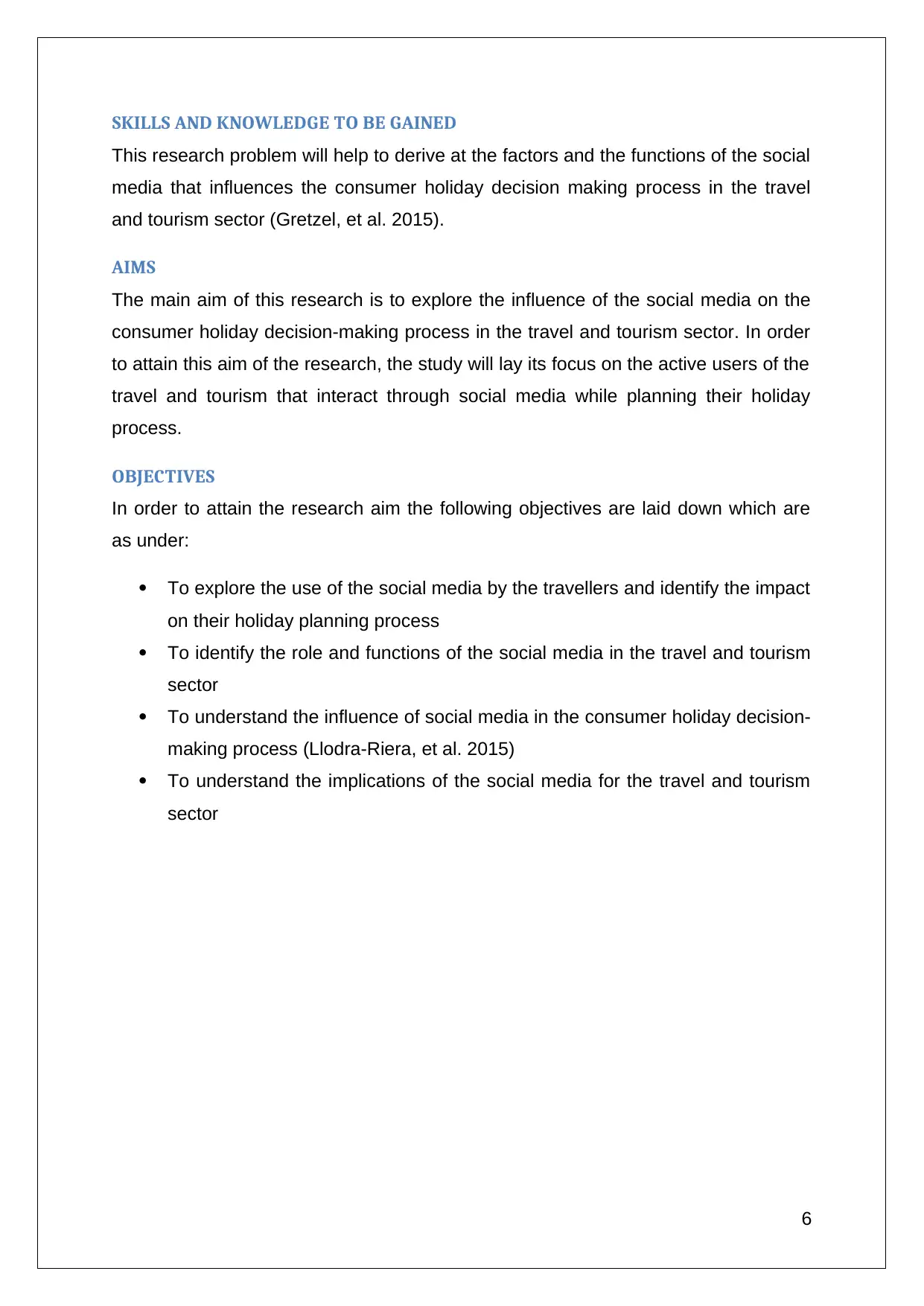
SKILLS AND KNOWLEDGE TO BE GAINED
This research problem will help to derive at the factors and the functions of the social
media that influences the consumer holiday decision making process in the travel
and tourism sector (Gretzel, et al. 2015).
AIMS
The main aim of this research is to explore the influence of the social media on the
consumer holiday decision-making process in the travel and tourism sector. In order
to attain this aim of the research, the study will lay its focus on the active users of the
travel and tourism that interact through social media while planning their holiday
process.
OBJECTIVES
In order to attain the research aim the following objectives are laid down which are
as under:
To explore the use of the social media by the travellers and identify the impact
on their holiday planning process
To identify the role and functions of the social media in the travel and tourism
sector
To understand the influence of social media in the consumer holiday decision-
making process (Llodra-Riera, et al. 2015)
To understand the implications of the social media for the travel and tourism
sector
6
This research problem will help to derive at the factors and the functions of the social
media that influences the consumer holiday decision making process in the travel
and tourism sector (Gretzel, et al. 2015).
AIMS
The main aim of this research is to explore the influence of the social media on the
consumer holiday decision-making process in the travel and tourism sector. In order
to attain this aim of the research, the study will lay its focus on the active users of the
travel and tourism that interact through social media while planning their holiday
process.
OBJECTIVES
In order to attain the research aim the following objectives are laid down which are
as under:
To explore the use of the social media by the travellers and identify the impact
on their holiday planning process
To identify the role and functions of the social media in the travel and tourism
sector
To understand the influence of social media in the consumer holiday decision-
making process (Llodra-Riera, et al. 2015)
To understand the implications of the social media for the travel and tourism
sector
6
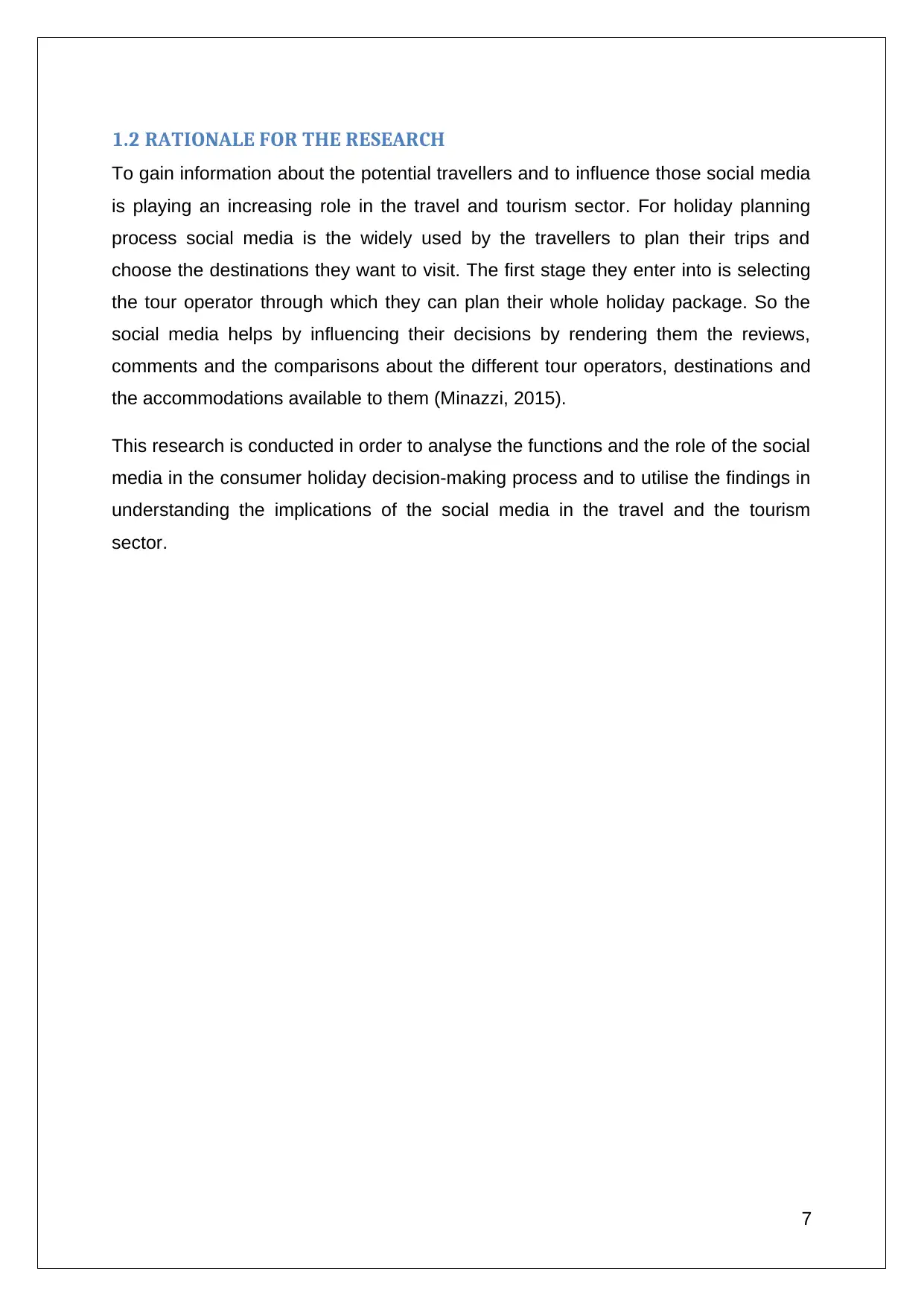
1.2 RATIONALE FOR THE RESEARCH
To gain information about the potential travellers and to influence those social media
is playing an increasing role in the travel and tourism sector. For holiday planning
process social media is the widely used by the travellers to plan their trips and
choose the destinations they want to visit. The first stage they enter into is selecting
the tour operator through which they can plan their whole holiday package. So the
social media helps by influencing their decisions by rendering them the reviews,
comments and the comparisons about the different tour operators, destinations and
the accommodations available to them (Minazzi, 2015).
This research is conducted in order to analyse the functions and the role of the social
media in the consumer holiday decision-making process and to utilise the findings in
understanding the implications of the social media in the travel and the tourism
sector.
7
To gain information about the potential travellers and to influence those social media
is playing an increasing role in the travel and tourism sector. For holiday planning
process social media is the widely used by the travellers to plan their trips and
choose the destinations they want to visit. The first stage they enter into is selecting
the tour operator through which they can plan their whole holiday package. So the
social media helps by influencing their decisions by rendering them the reviews,
comments and the comparisons about the different tour operators, destinations and
the accommodations available to them (Minazzi, 2015).
This research is conducted in order to analyse the functions and the role of the social
media in the consumer holiday decision-making process and to utilise the findings in
understanding the implications of the social media in the travel and the tourism
sector.
7
Paraphrase This Document
Need a fresh take? Get an instant paraphrase of this document with our AI Paraphraser
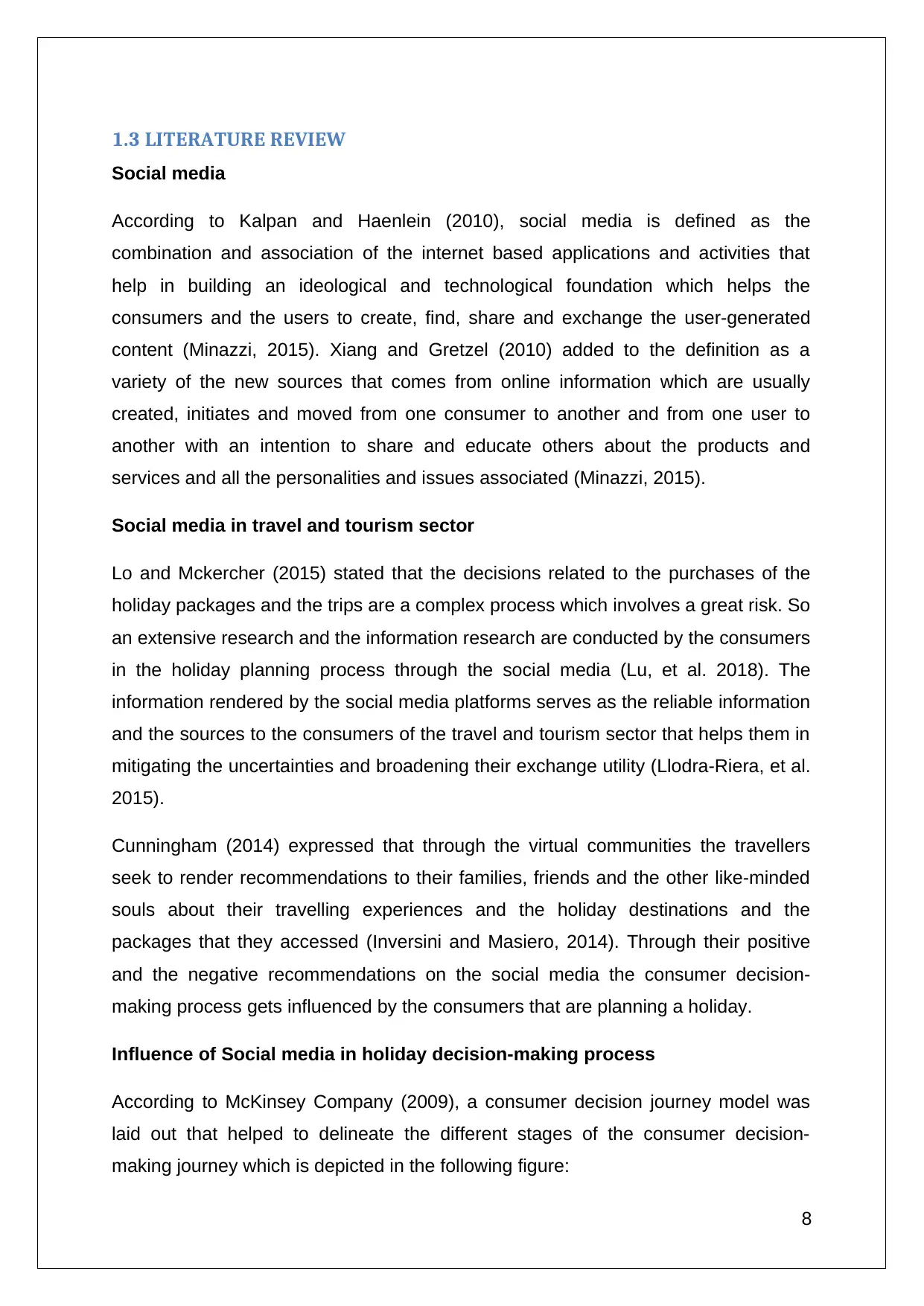
1.3 LITERATURE REVIEW
Social media
According to Kalpan and Haenlein (2010), social media is defined as the
combination and association of the internet based applications and activities that
help in building an ideological and technological foundation which helps the
consumers and the users to create, find, share and exchange the user-generated
content (Minazzi, 2015). Xiang and Gretzel (2010) added to the definition as a
variety of the new sources that comes from online information which are usually
created, initiates and moved from one consumer to another and from one user to
another with an intention to share and educate others about the products and
services and all the personalities and issues associated (Minazzi, 2015).
Social media in travel and tourism sector
Lo and Mckercher (2015) stated that the decisions related to the purchases of the
holiday packages and the trips are a complex process which involves a great risk. So
an extensive research and the information research are conducted by the consumers
in the holiday planning process through the social media (Lu, et al. 2018). The
information rendered by the social media platforms serves as the reliable information
and the sources to the consumers of the travel and tourism sector that helps them in
mitigating the uncertainties and broadening their exchange utility (Llodra-Riera, et al.
2015).
Cunningham (2014) expressed that through the virtual communities the travellers
seek to render recommendations to their families, friends and the other like-minded
souls about their travelling experiences and the holiday destinations and the
packages that they accessed (Inversini and Masiero, 2014). Through their positive
and the negative recommendations on the social media the consumer decision-
making process gets influenced by the consumers that are planning a holiday.
Influence of Social media in holiday decision-making process
According to McKinsey Company (2009), a consumer decision journey model was
laid out that helped to delineate the different stages of the consumer decision-
making journey which is depicted in the following figure:
8
Social media
According to Kalpan and Haenlein (2010), social media is defined as the
combination and association of the internet based applications and activities that
help in building an ideological and technological foundation which helps the
consumers and the users to create, find, share and exchange the user-generated
content (Minazzi, 2015). Xiang and Gretzel (2010) added to the definition as a
variety of the new sources that comes from online information which are usually
created, initiates and moved from one consumer to another and from one user to
another with an intention to share and educate others about the products and
services and all the personalities and issues associated (Minazzi, 2015).
Social media in travel and tourism sector
Lo and Mckercher (2015) stated that the decisions related to the purchases of the
holiday packages and the trips are a complex process which involves a great risk. So
an extensive research and the information research are conducted by the consumers
in the holiday planning process through the social media (Lu, et al. 2018). The
information rendered by the social media platforms serves as the reliable information
and the sources to the consumers of the travel and tourism sector that helps them in
mitigating the uncertainties and broadening their exchange utility (Llodra-Riera, et al.
2015).
Cunningham (2014) expressed that through the virtual communities the travellers
seek to render recommendations to their families, friends and the other like-minded
souls about their travelling experiences and the holiday destinations and the
packages that they accessed (Inversini and Masiero, 2014). Through their positive
and the negative recommendations on the social media the consumer decision-
making process gets influenced by the consumers that are planning a holiday.
Influence of Social media in holiday decision-making process
According to McKinsey Company (2009), a consumer decision journey model was
laid out that helped to delineate the different stages of the consumer decision-
making journey which is depicted in the following figure:
8
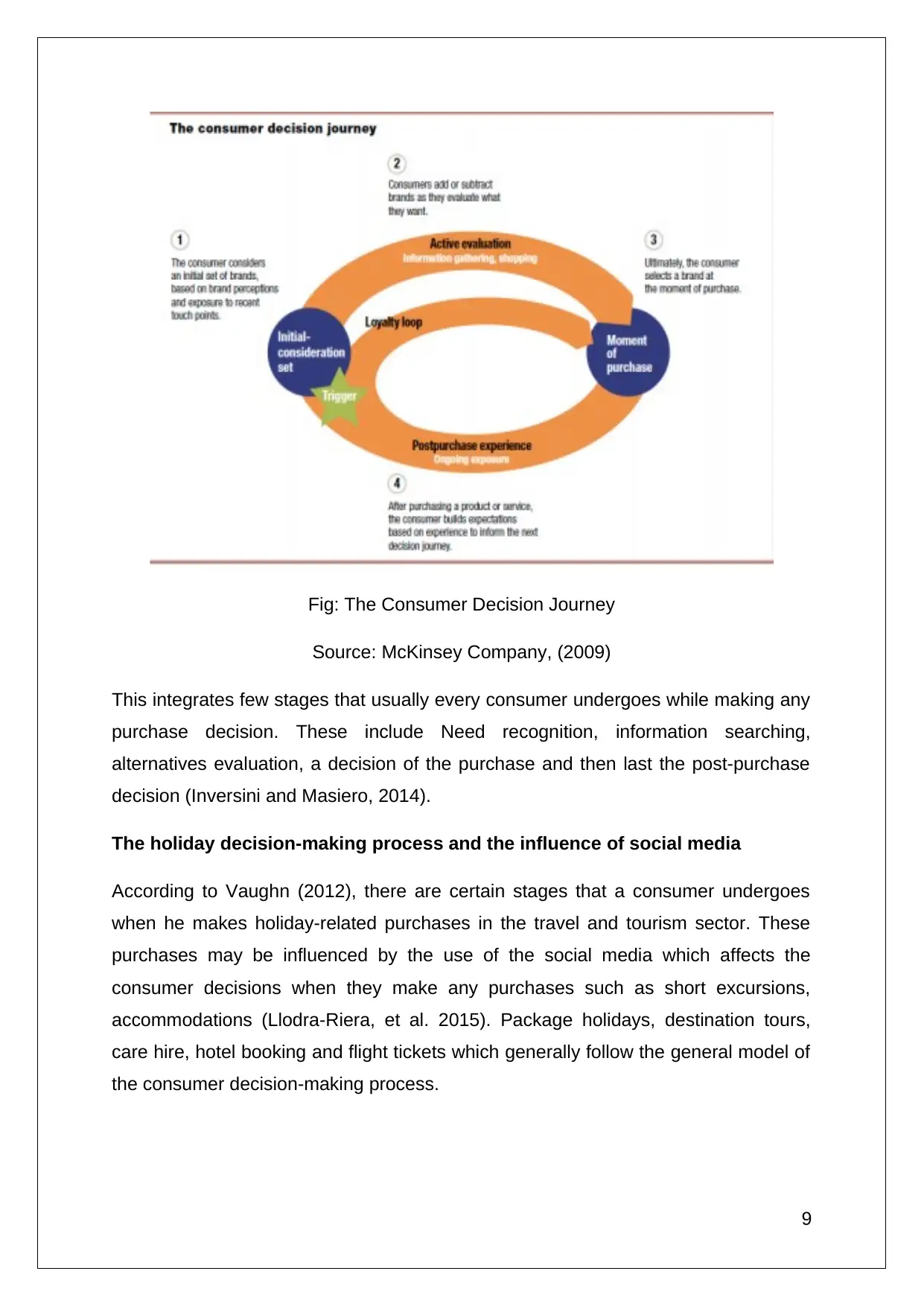
Fig: The Consumer Decision Journey
Source: McKinsey Company, (2009)
This integrates few stages that usually every consumer undergoes while making any
purchase decision. These include Need recognition, information searching,
alternatives evaluation, a decision of the purchase and then last the post-purchase
decision (Inversini and Masiero, 2014).
The holiday decision-making process and the influence of social media
According to Vaughn (2012), there are certain stages that a consumer undergoes
when he makes holiday-related purchases in the travel and tourism sector. These
purchases may be influenced by the use of the social media which affects the
consumer decisions when they make any purchases such as short excursions,
accommodations (Llodra-Riera, et al. 2015). Package holidays, destination tours,
care hire, hotel booking and flight tickets which generally follow the general model of
the consumer decision-making process.
9
Source: McKinsey Company, (2009)
This integrates few stages that usually every consumer undergoes while making any
purchase decision. These include Need recognition, information searching,
alternatives evaluation, a decision of the purchase and then last the post-purchase
decision (Inversini and Masiero, 2014).
The holiday decision-making process and the influence of social media
According to Vaughn (2012), there are certain stages that a consumer undergoes
when he makes holiday-related purchases in the travel and tourism sector. These
purchases may be influenced by the use of the social media which affects the
consumer decisions when they make any purchases such as short excursions,
accommodations (Llodra-Riera, et al. 2015). Package holidays, destination tours,
care hire, hotel booking and flight tickets which generally follow the general model of
the consumer decision-making process.
9
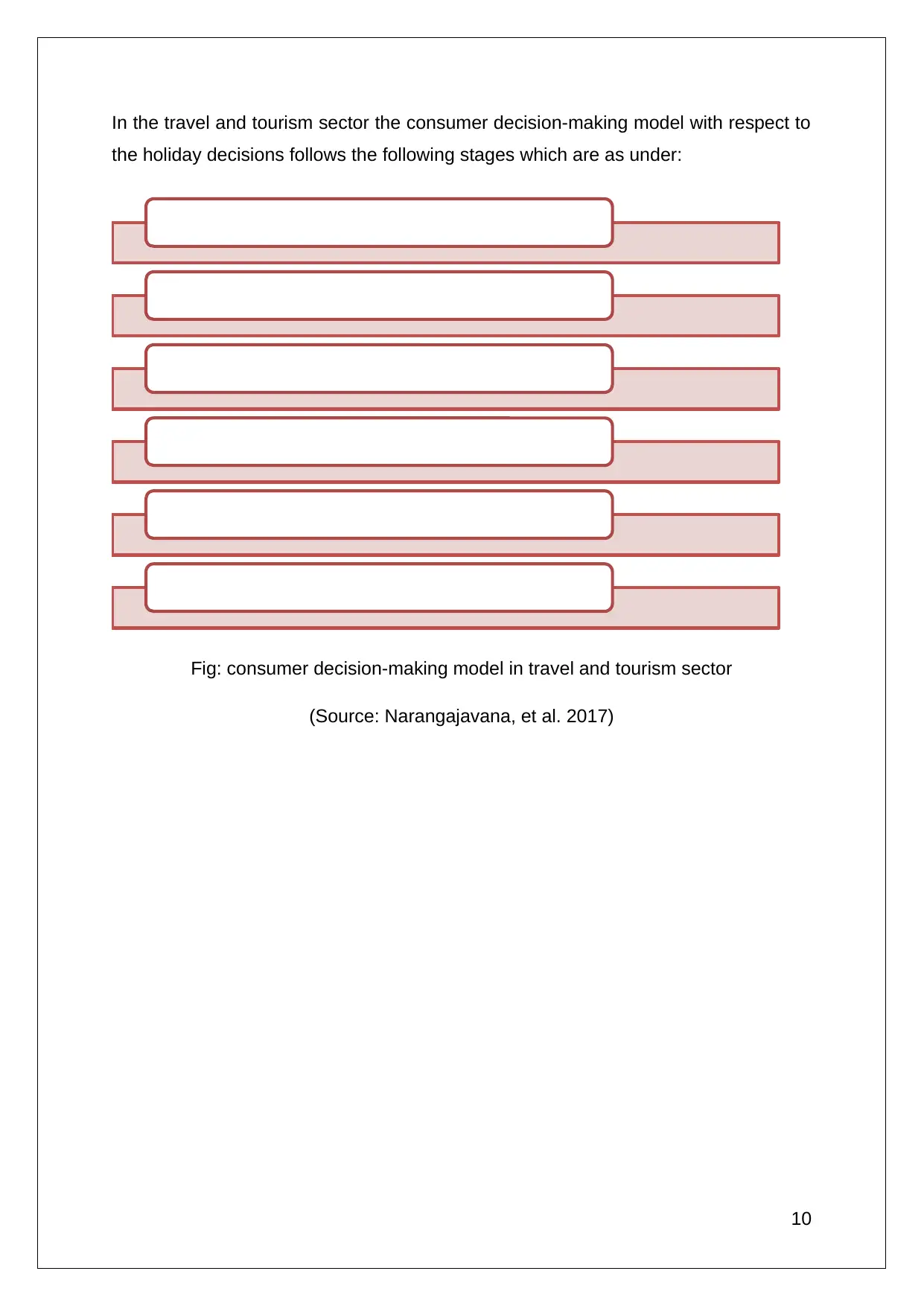
In the travel and tourism sector the consumer decision-making model with respect to
the holiday decisions follows the following stages which are as under:
Fig: consumer decision-making model in travel and tourism sector
(Source: Narangajavana, et al. 2017)
10
Need recognition
Information search
Evaluation of alternatives
Purchase decision
Consumption
Post consumption evaluation
the holiday decisions follows the following stages which are as under:
Fig: consumer decision-making model in travel and tourism sector
(Source: Narangajavana, et al. 2017)
10
Need recognition
Information search
Evaluation of alternatives
Purchase decision
Consumption
Post consumption evaluation
Secure Best Marks with AI Grader
Need help grading? Try our AI Grader for instant feedback on your assignments.
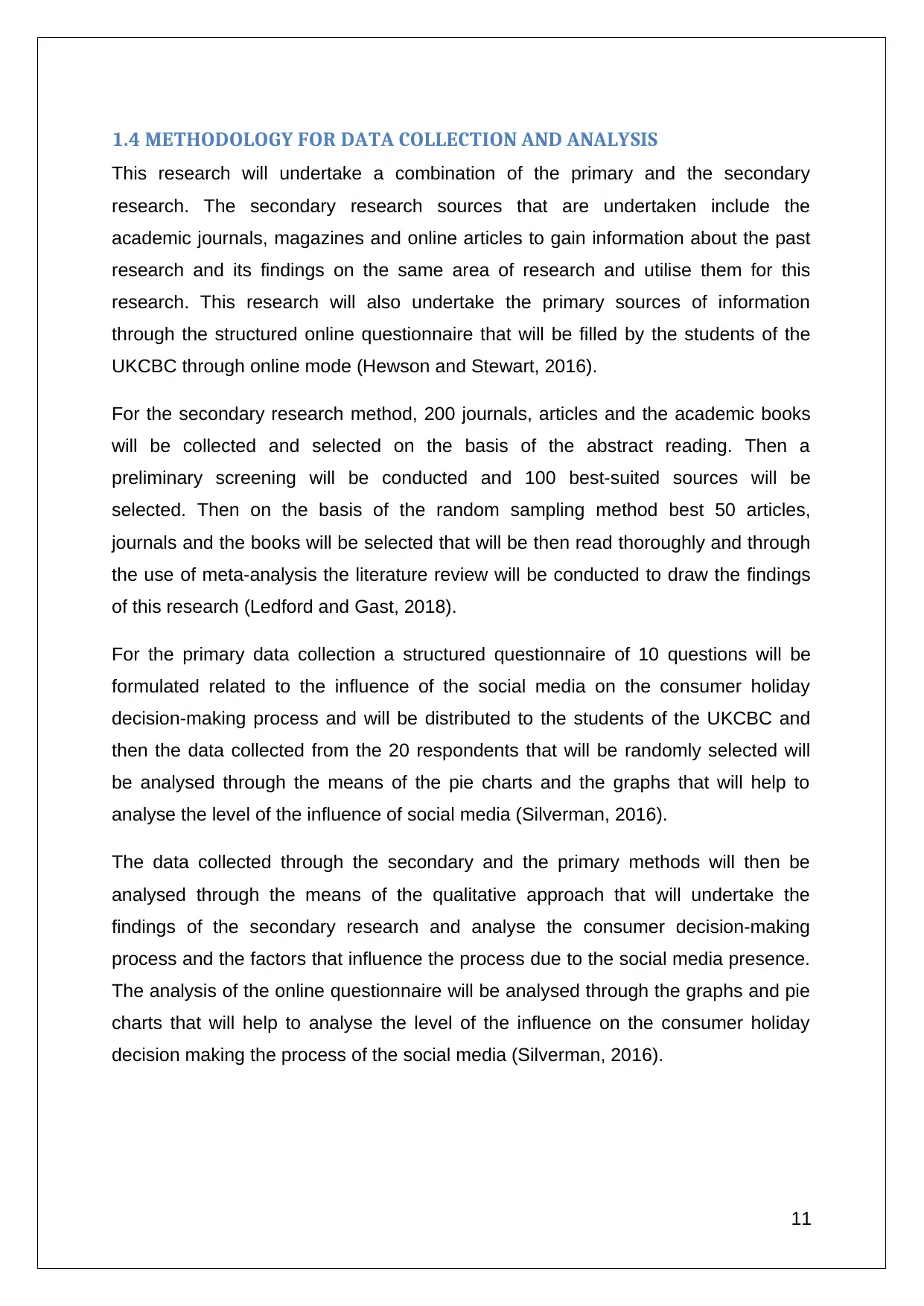
1.4 METHODOLOGY FOR DATA COLLECTION AND ANALYSIS
This research will undertake a combination of the primary and the secondary
research. The secondary research sources that are undertaken include the
academic journals, magazines and online articles to gain information about the past
research and its findings on the same area of research and utilise them for this
research. This research will also undertake the primary sources of information
through the structured online questionnaire that will be filled by the students of the
UKCBC through online mode (Hewson and Stewart, 2016).
For the secondary research method, 200 journals, articles and the academic books
will be collected and selected on the basis of the abstract reading. Then a
preliminary screening will be conducted and 100 best-suited sources will be
selected. Then on the basis of the random sampling method best 50 articles,
journals and the books will be selected that will be then read thoroughly and through
the use of meta-analysis the literature review will be conducted to draw the findings
of this research (Ledford and Gast, 2018).
For the primary data collection a structured questionnaire of 10 questions will be
formulated related to the influence of the social media on the consumer holiday
decision-making process and will be distributed to the students of the UKCBC and
then the data collected from the 20 respondents that will be randomly selected will
be analysed through the means of the pie charts and the graphs that will help to
analyse the level of the influence of social media (Silverman, 2016).
The data collected through the secondary and the primary methods will then be
analysed through the means of the qualitative approach that will undertake the
findings of the secondary research and analyse the consumer decision-making
process and the factors that influence the process due to the social media presence.
The analysis of the online questionnaire will be analysed through the graphs and pie
charts that will help to analyse the level of the influence on the consumer holiday
decision making the process of the social media (Silverman, 2016).
11
This research will undertake a combination of the primary and the secondary
research. The secondary research sources that are undertaken include the
academic journals, magazines and online articles to gain information about the past
research and its findings on the same area of research and utilise them for this
research. This research will also undertake the primary sources of information
through the structured online questionnaire that will be filled by the students of the
UKCBC through online mode (Hewson and Stewart, 2016).
For the secondary research method, 200 journals, articles and the academic books
will be collected and selected on the basis of the abstract reading. Then a
preliminary screening will be conducted and 100 best-suited sources will be
selected. Then on the basis of the random sampling method best 50 articles,
journals and the books will be selected that will be then read thoroughly and through
the use of meta-analysis the literature review will be conducted to draw the findings
of this research (Ledford and Gast, 2018).
For the primary data collection a structured questionnaire of 10 questions will be
formulated related to the influence of the social media on the consumer holiday
decision-making process and will be distributed to the students of the UKCBC and
then the data collected from the 20 respondents that will be randomly selected will
be analysed through the means of the pie charts and the graphs that will help to
analyse the level of the influence of social media (Silverman, 2016).
The data collected through the secondary and the primary methods will then be
analysed through the means of the qualitative approach that will undertake the
findings of the secondary research and analyse the consumer decision-making
process and the factors that influence the process due to the social media presence.
The analysis of the online questionnaire will be analysed through the graphs and pie
charts that will help to analyse the level of the influence on the consumer holiday
decision making the process of the social media (Silverman, 2016).
11
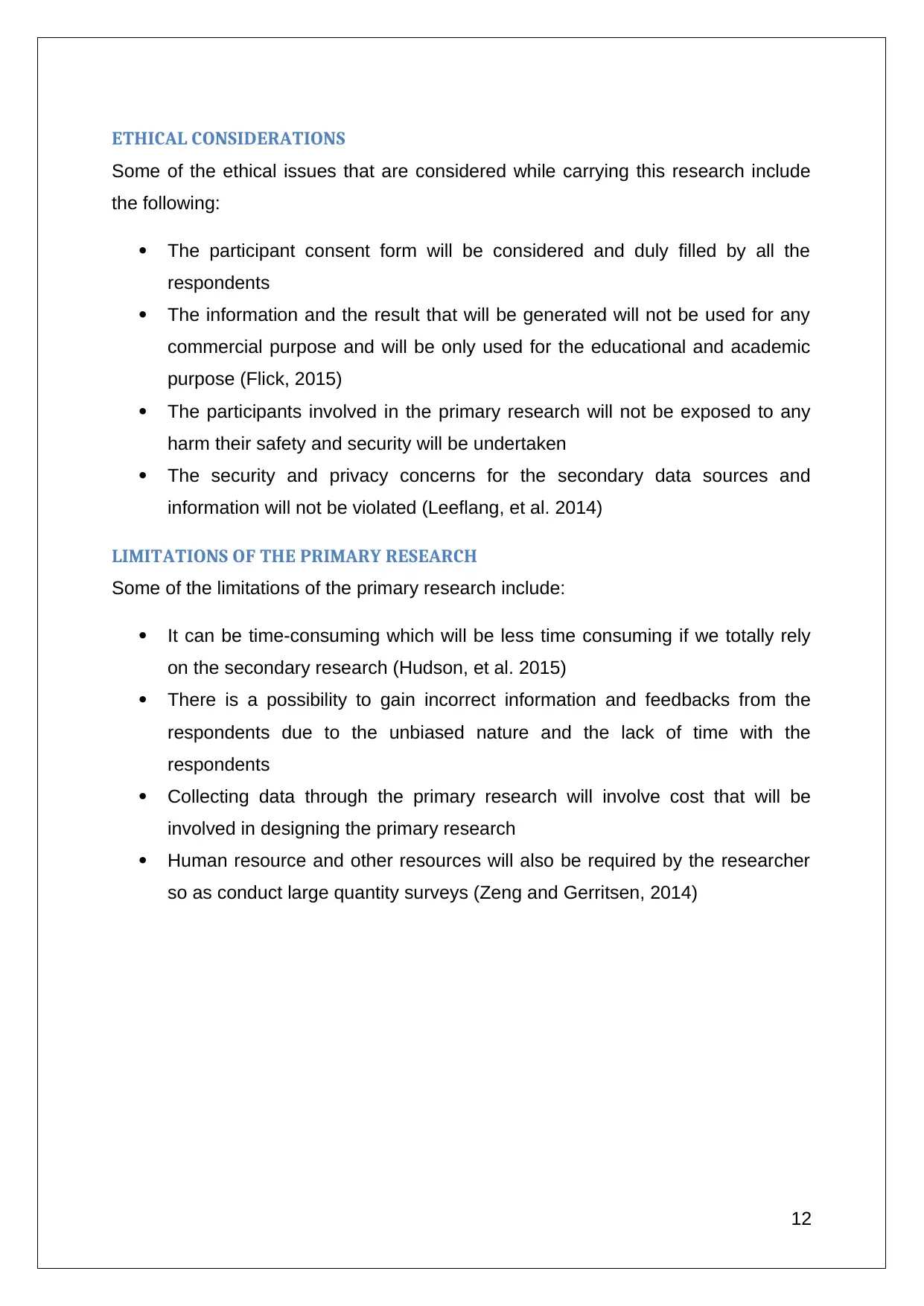
ETHICAL CONSIDERATIONS
Some of the ethical issues that are considered while carrying this research include
the following:
The participant consent form will be considered and duly filled by all the
respondents
The information and the result that will be generated will not be used for any
commercial purpose and will be only used for the educational and academic
purpose (Flick, 2015)
The participants involved in the primary research will not be exposed to any
harm their safety and security will be undertaken
The security and privacy concerns for the secondary data sources and
information will not be violated (Leeflang, et al. 2014)
LIMITATIONS OF THE PRIMARY RESEARCH
Some of the limitations of the primary research include:
It can be time-consuming which will be less time consuming if we totally rely
on the secondary research (Hudson, et al. 2015)
There is a possibility to gain incorrect information and feedbacks from the
respondents due to the unbiased nature and the lack of time with the
respondents
Collecting data through the primary research will involve cost that will be
involved in designing the primary research
Human resource and other resources will also be required by the researcher
so as conduct large quantity surveys (Zeng and Gerritsen, 2014)
12
Some of the ethical issues that are considered while carrying this research include
the following:
The participant consent form will be considered and duly filled by all the
respondents
The information and the result that will be generated will not be used for any
commercial purpose and will be only used for the educational and academic
purpose (Flick, 2015)
The participants involved in the primary research will not be exposed to any
harm their safety and security will be undertaken
The security and privacy concerns for the secondary data sources and
information will not be violated (Leeflang, et al. 2014)
LIMITATIONS OF THE PRIMARY RESEARCH
Some of the limitations of the primary research include:
It can be time-consuming which will be less time consuming if we totally rely
on the secondary research (Hudson, et al. 2015)
There is a possibility to gain incorrect information and feedbacks from the
respondents due to the unbiased nature and the lack of time with the
respondents
Collecting data through the primary research will involve cost that will be
involved in designing the primary research
Human resource and other resources will also be required by the researcher
so as conduct large quantity surveys (Zeng and Gerritsen, 2014)
12

RESEARCH DESIGN
Fig: Research design
Source: (Mackey and Gass, 2015)
13
Defining the research problem
Defining aims and objectives
Literature review
Design the research
Primary Data Collection
1
2
3
4
Analysing the data
Interpreting and reporting the data
Conclusions and recommendations
6
7
5
Fig: Research design
Source: (Mackey and Gass, 2015)
13
Defining the research problem
Defining aims and objectives
Literature review
Design the research
Primary Data Collection
1
2
3
4
Analysing the data
Interpreting and reporting the data
Conclusions and recommendations
6
7
5
Paraphrase This Document
Need a fresh take? Get an instant paraphrase of this document with our AI Paraphraser
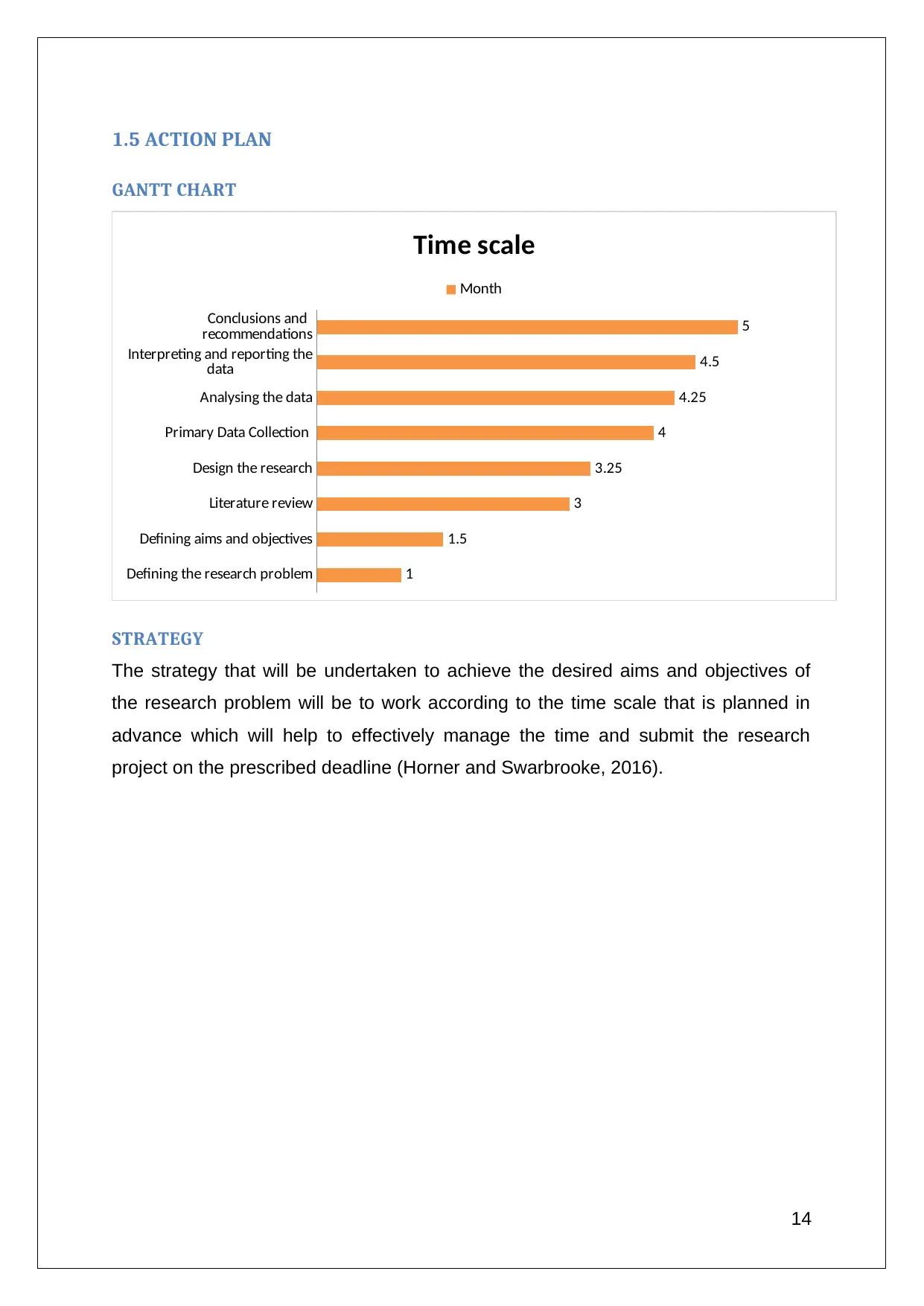
1.5 ACTION PLAN
GANTT CHART
Defining the research problem
Defining aims and objectives
Literature review
Design the research
Primary Data Collection
Analysing the data
Interpreting and reporting the
data
Conclusions and
recommendations
1
1.5
3
3.25
4
4.25
4.5
5
Time scale
Month
STRATEGY
The strategy that will be undertaken to achieve the desired aims and objectives of
the research problem will be to work according to the time scale that is planned in
advance which will help to effectively manage the time and submit the research
project on the prescribed deadline (Horner and Swarbrooke, 2016).
14
GANTT CHART
Defining the research problem
Defining aims and objectives
Literature review
Design the research
Primary Data Collection
Analysing the data
Interpreting and reporting the
data
Conclusions and
recommendations
1
1.5
3
3.25
4
4.25
4.5
5
Time scale
Month
STRATEGY
The strategy that will be undertaken to achieve the desired aims and objectives of
the research problem will be to work according to the time scale that is planned in
advance which will help to effectively manage the time and submit the research
project on the prescribed deadline (Horner and Swarbrooke, 2016).
14
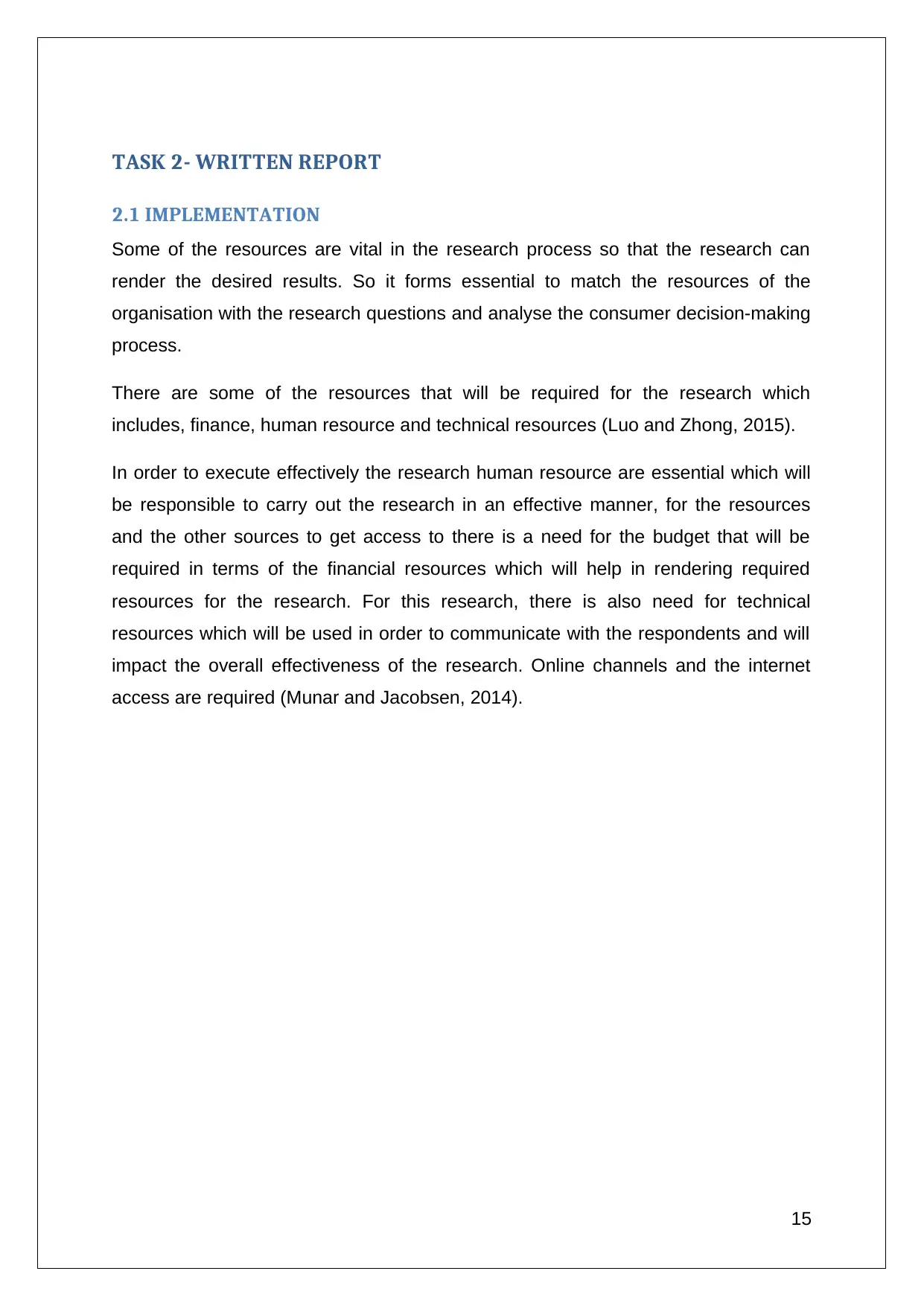
TASK 2- WRITTEN REPORT
2.1 IMPLEMENTATION
Some of the resources are vital in the research process so that the research can
render the desired results. So it forms essential to match the resources of the
organisation with the research questions and analyse the consumer decision-making
process.
There are some of the resources that will be required for the research which
includes, finance, human resource and technical resources (Luo and Zhong, 2015).
In order to execute effectively the research human resource are essential which will
be responsible to carry out the research in an effective manner, for the resources
and the other sources to get access to there is a need for the budget that will be
required in terms of the financial resources which will help in rendering required
resources for the research. For this research, there is also need for technical
resources which will be used in order to communicate with the respondents and will
impact the overall effectiveness of the research. Online channels and the internet
access are required (Munar and Jacobsen, 2014).
15
2.1 IMPLEMENTATION
Some of the resources are vital in the research process so that the research can
render the desired results. So it forms essential to match the resources of the
organisation with the research questions and analyse the consumer decision-making
process.
There are some of the resources that will be required for the research which
includes, finance, human resource and technical resources (Luo and Zhong, 2015).
In order to execute effectively the research human resource are essential which will
be responsible to carry out the research in an effective manner, for the resources
and the other sources to get access to there is a need for the budget that will be
required in terms of the financial resources which will help in rendering required
resources for the research. For this research, there is also need for technical
resources which will be used in order to communicate with the respondents and will
impact the overall effectiveness of the research. Online channels and the internet
access are required (Munar and Jacobsen, 2014).
15
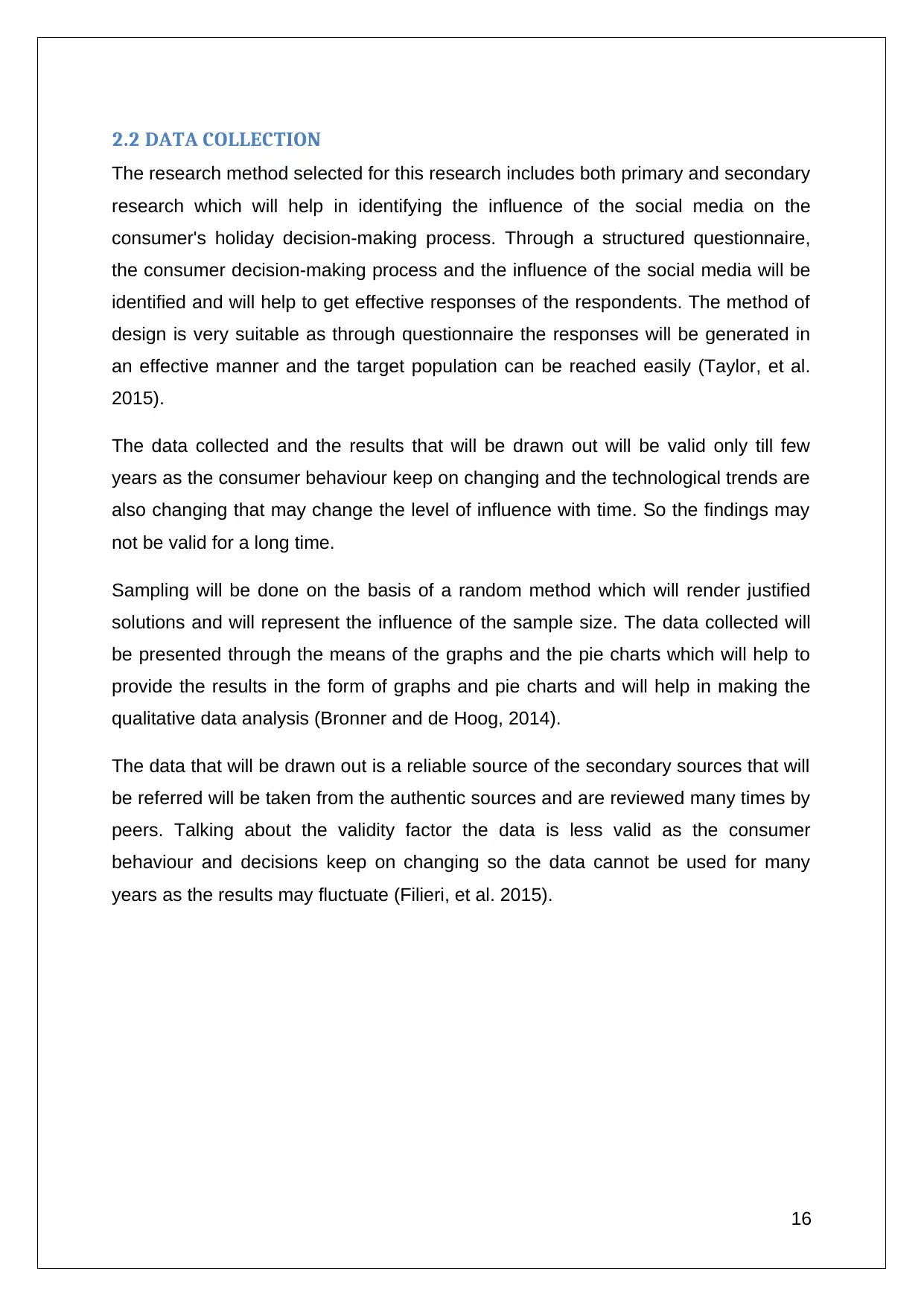
2.2 DATA COLLECTION
The research method selected for this research includes both primary and secondary
research which will help in identifying the influence of the social media on the
consumer's holiday decision-making process. Through a structured questionnaire,
the consumer decision-making process and the influence of the social media will be
identified and will help to get effective responses of the respondents. The method of
design is very suitable as through questionnaire the responses will be generated in
an effective manner and the target population can be reached easily (Taylor, et al.
2015).
The data collected and the results that will be drawn out will be valid only till few
years as the consumer behaviour keep on changing and the technological trends are
also changing that may change the level of influence with time. So the findings may
not be valid for a long time.
Sampling will be done on the basis of a random method which will render justified
solutions and will represent the influence of the sample size. The data collected will
be presented through the means of the graphs and the pie charts which will help to
provide the results in the form of graphs and pie charts and will help in making the
qualitative data analysis (Bronner and de Hoog, 2014).
The data that will be drawn out is a reliable source of the secondary sources that will
be referred will be taken from the authentic sources and are reviewed many times by
peers. Talking about the validity factor the data is less valid as the consumer
behaviour and decisions keep on changing so the data cannot be used for many
years as the results may fluctuate (Filieri, et al. 2015).
16
The research method selected for this research includes both primary and secondary
research which will help in identifying the influence of the social media on the
consumer's holiday decision-making process. Through a structured questionnaire,
the consumer decision-making process and the influence of the social media will be
identified and will help to get effective responses of the respondents. The method of
design is very suitable as through questionnaire the responses will be generated in
an effective manner and the target population can be reached easily (Taylor, et al.
2015).
The data collected and the results that will be drawn out will be valid only till few
years as the consumer behaviour keep on changing and the technological trends are
also changing that may change the level of influence with time. So the findings may
not be valid for a long time.
Sampling will be done on the basis of a random method which will render justified
solutions and will represent the influence of the sample size. The data collected will
be presented through the means of the graphs and the pie charts which will help to
provide the results in the form of graphs and pie charts and will help in making the
qualitative data analysis (Bronner and de Hoog, 2014).
The data that will be drawn out is a reliable source of the secondary sources that will
be referred will be taken from the authentic sources and are reviewed many times by
peers. Talking about the validity factor the data is less valid as the consumer
behaviour and decisions keep on changing so the data cannot be used for many
years as the results may fluctuate (Filieri, et al. 2015).
16
Secure Best Marks with AI Grader
Need help grading? Try our AI Grader for instant feedback on your assignments.
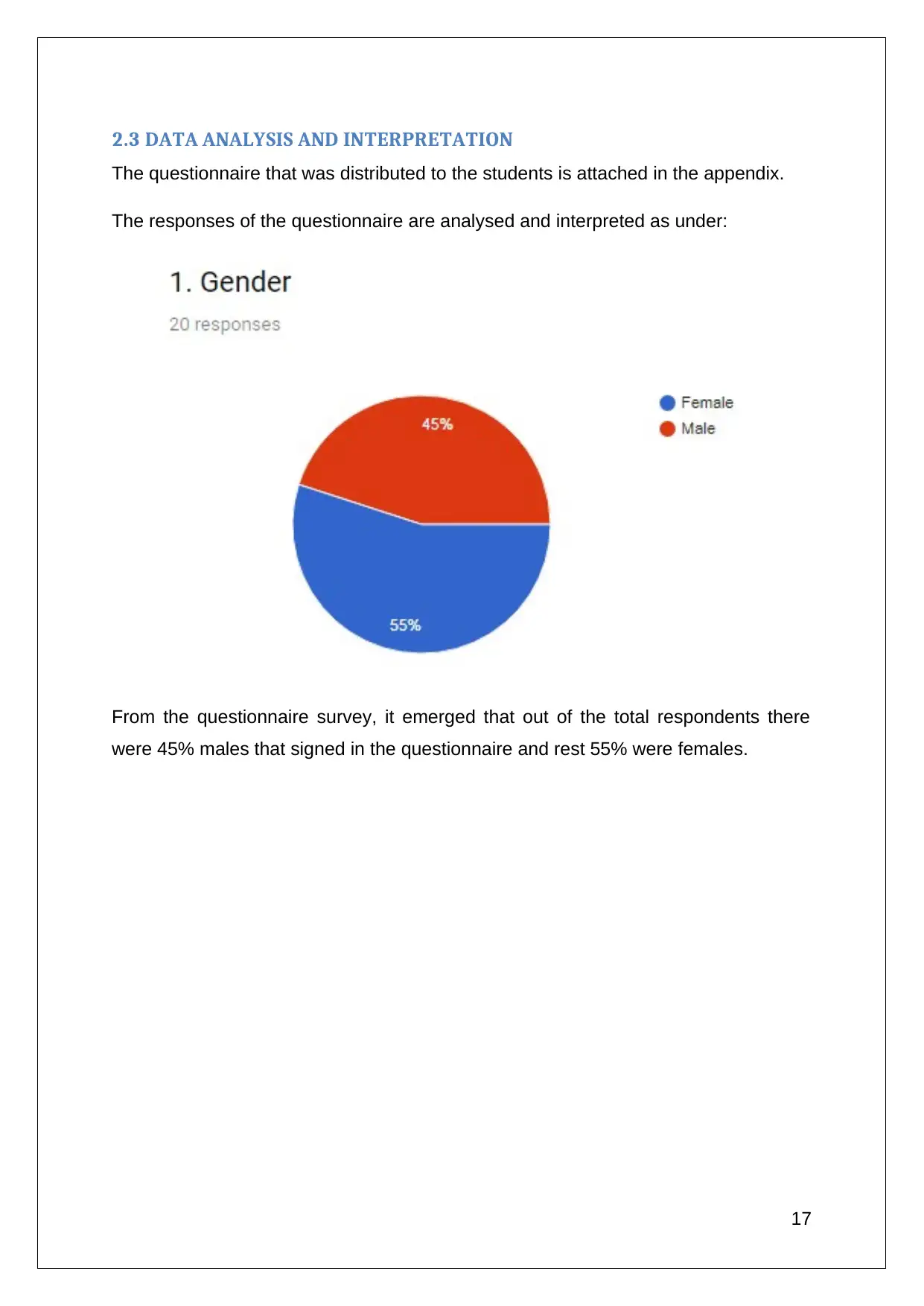
2.3 DATA ANALYSIS AND INTERPRETATION
The questionnaire that was distributed to the students is attached in the appendix.
The responses of the questionnaire are analysed and interpreted as under:
From the questionnaire survey, it emerged that out of the total respondents there
were 45% males that signed in the questionnaire and rest 55% were females.
17
The questionnaire that was distributed to the students is attached in the appendix.
The responses of the questionnaire are analysed and interpreted as under:
From the questionnaire survey, it emerged that out of the total respondents there
were 45% males that signed in the questionnaire and rest 55% were females.
17
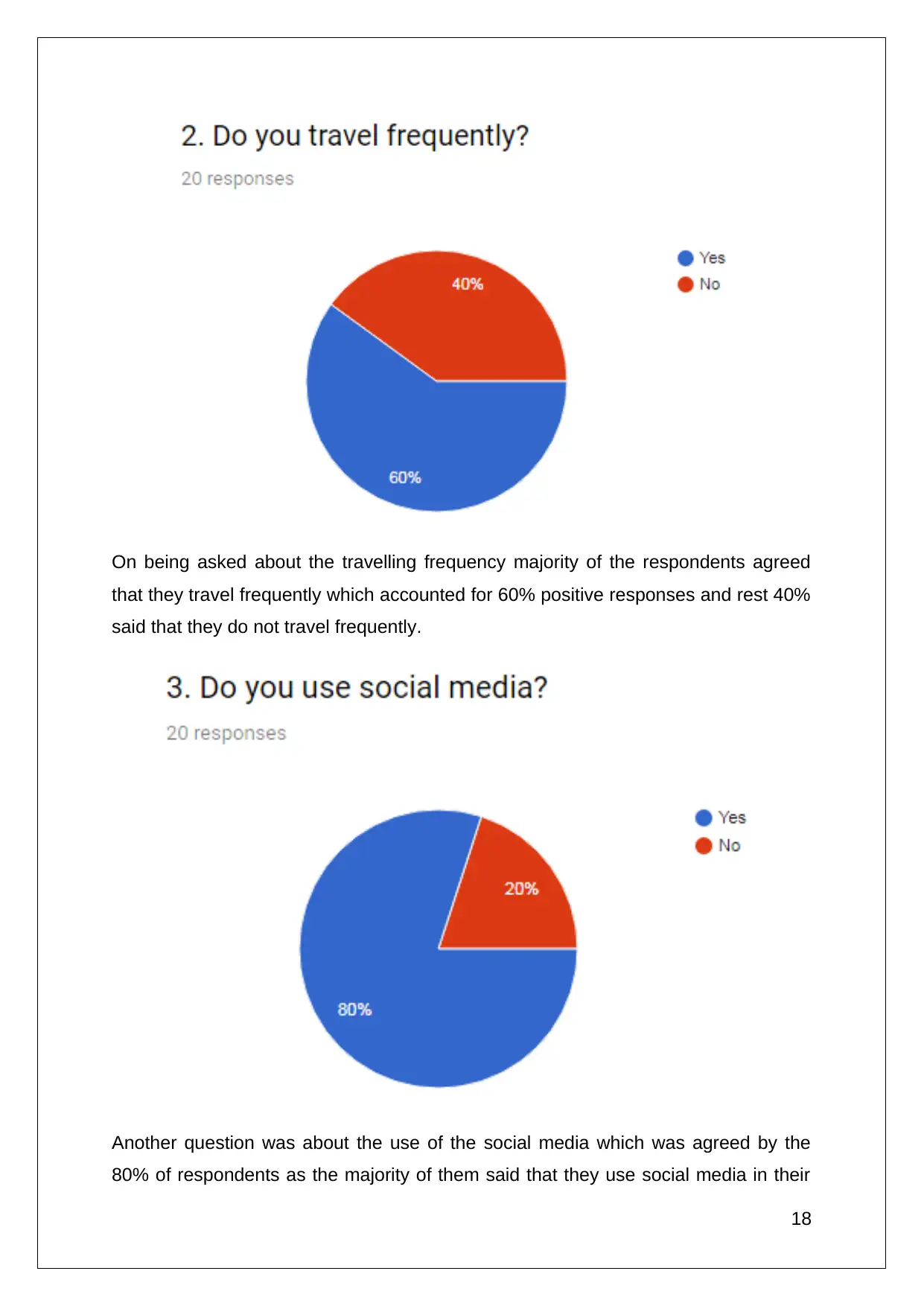
On being asked about the travelling frequency majority of the respondents agreed
that they travel frequently which accounted for 60% positive responses and rest 40%
said that they do not travel frequently.
Another question was about the use of the social media which was agreed by the
80% of respondents as the majority of them said that they use social media in their
18
that they travel frequently which accounted for 60% positive responses and rest 40%
said that they do not travel frequently.
Another question was about the use of the social media which was agreed by the
80% of respondents as the majority of them said that they use social media in their
18
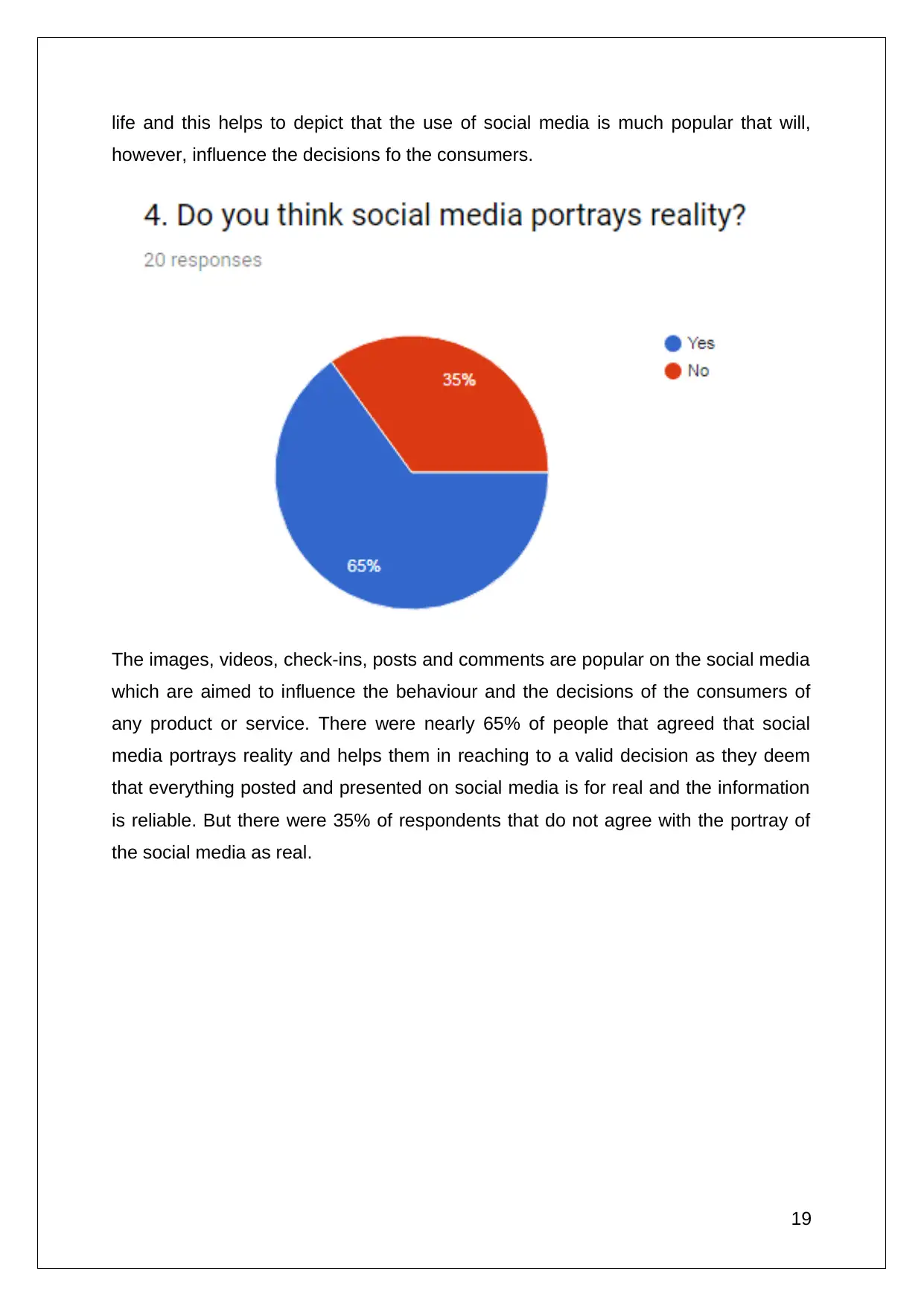
life and this helps to depict that the use of social media is much popular that will,
however, influence the decisions fo the consumers.
The images, videos, check-ins, posts and comments are popular on the social media
which are aimed to influence the behaviour and the decisions of the consumers of
any product or service. There were nearly 65% of people that agreed that social
media portrays reality and helps them in reaching to a valid decision as they deem
that everything posted and presented on social media is for real and the information
is reliable. But there were 35% of respondents that do not agree with the portray of
the social media as real.
19
however, influence the decisions fo the consumers.
The images, videos, check-ins, posts and comments are popular on the social media
which are aimed to influence the behaviour and the decisions of the consumers of
any product or service. There were nearly 65% of people that agreed that social
media portrays reality and helps them in reaching to a valid decision as they deem
that everything posted and presented on social media is for real and the information
is reliable. But there were 35% of respondents that do not agree with the portray of
the social media as real.
19
Paraphrase This Document
Need a fresh take? Get an instant paraphrase of this document with our AI Paraphraser
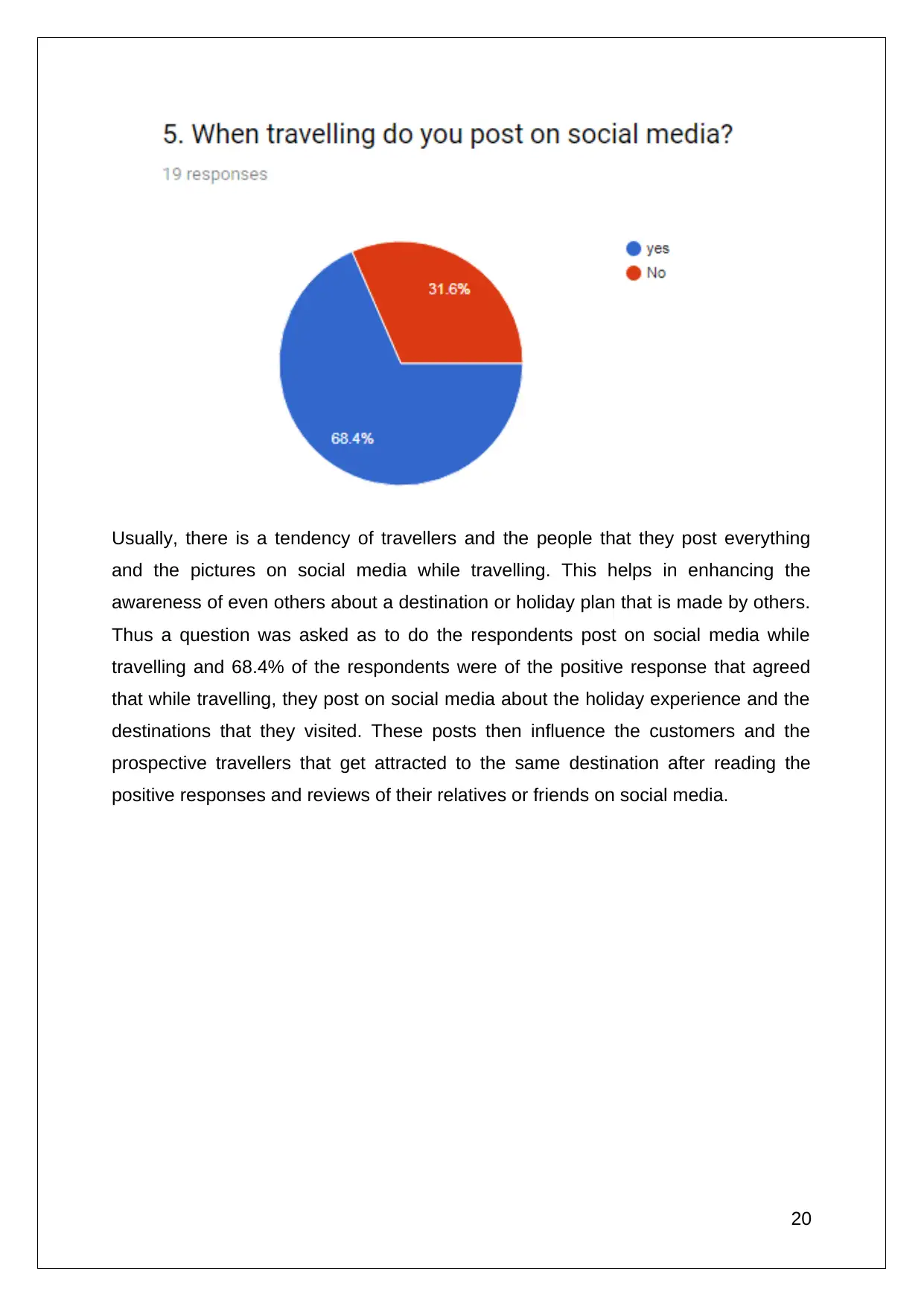
Usually, there is a tendency of travellers and the people that they post everything
and the pictures on social media while travelling. This helps in enhancing the
awareness of even others about a destination or holiday plan that is made by others.
Thus a question was asked as to do the respondents post on social media while
travelling and 68.4% of the respondents were of the positive response that agreed
that while travelling, they post on social media about the holiday experience and the
destinations that they visited. These posts then influence the customers and the
prospective travellers that get attracted to the same destination after reading the
positive responses and reviews of their relatives or friends on social media.
20
and the pictures on social media while travelling. This helps in enhancing the
awareness of even others about a destination or holiday plan that is made by others.
Thus a question was asked as to do the respondents post on social media while
travelling and 68.4% of the respondents were of the positive response that agreed
that while travelling, they post on social media about the holiday experience and the
destinations that they visited. These posts then influence the customers and the
prospective travellers that get attracted to the same destination after reading the
positive responses and reviews of their relatives or friends on social media.
20
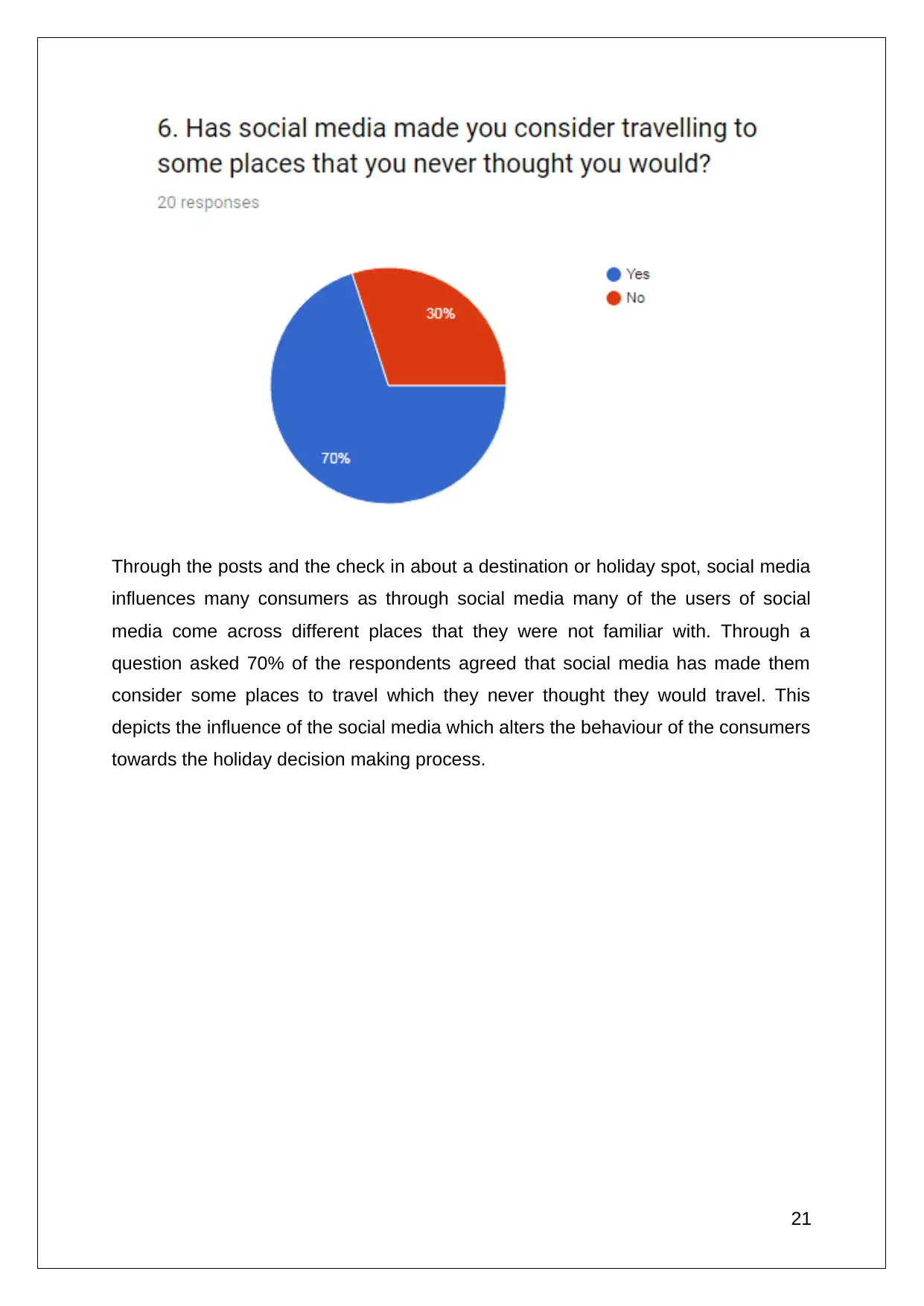
Through the posts and the check in about a destination or holiday spot, social media
influences many consumers as through social media many of the users of social
media come across different places that they were not familiar with. Through a
question asked 70% of the respondents agreed that social media has made them
consider some places to travel which they never thought they would travel. This
depicts the influence of the social media which alters the behaviour of the consumers
towards the holiday decision making process.
21
influences many consumers as through social media many of the users of social
media come across different places that they were not familiar with. Through a
question asked 70% of the respondents agreed that social media has made them
consider some places to travel which they never thought they would travel. This
depicts the influence of the social media which alters the behaviour of the consumers
towards the holiday decision making process.
21
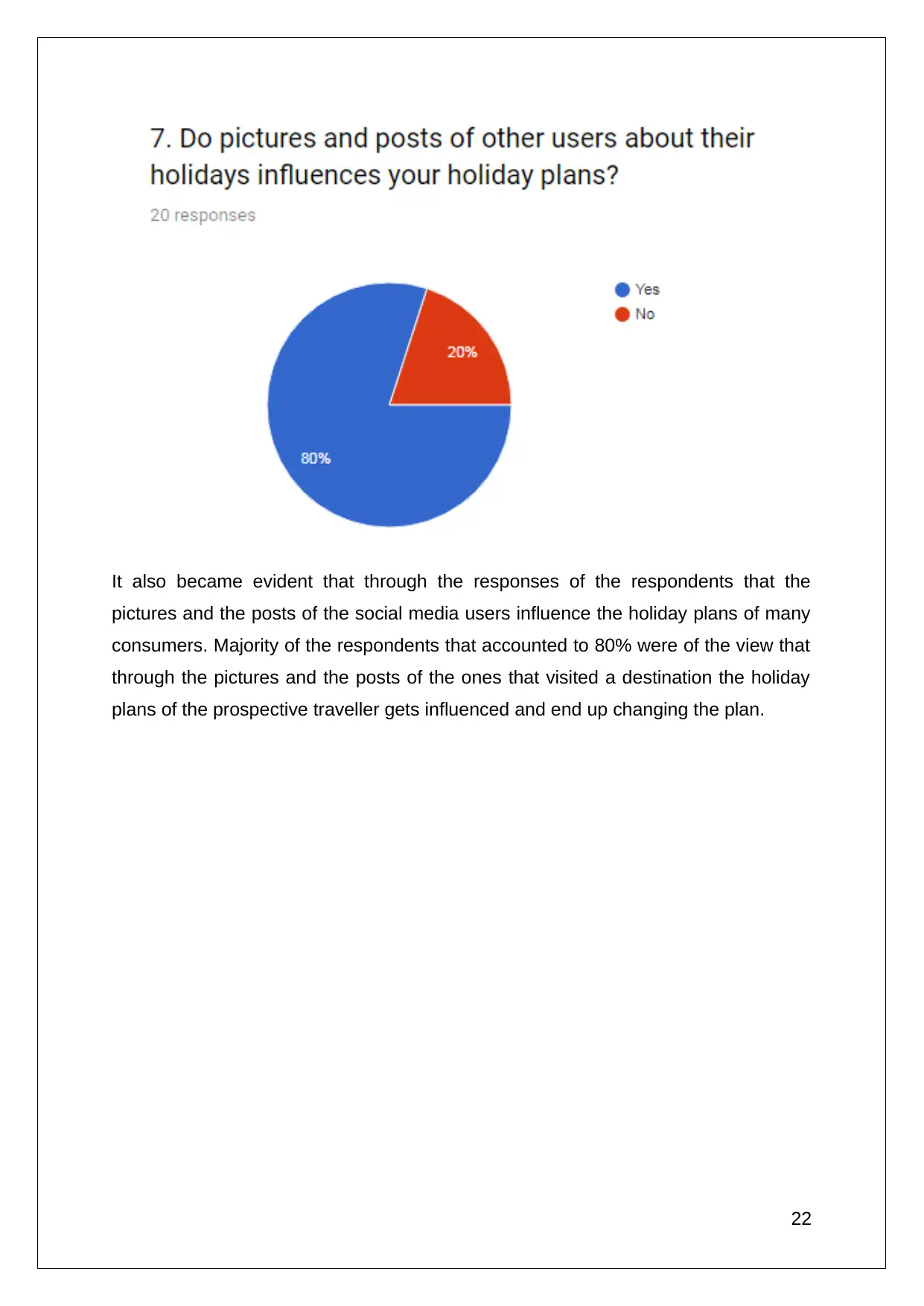
It also became evident that through the responses of the respondents that the
pictures and the posts of the social media users influence the holiday plans of many
consumers. Majority of the respondents that accounted to 80% were of the view that
through the pictures and the posts of the ones that visited a destination the holiday
plans of the prospective traveller gets influenced and end up changing the plan.
22
pictures and the posts of the social media users influence the holiday plans of many
consumers. Majority of the respondents that accounted to 80% were of the view that
through the pictures and the posts of the ones that visited a destination the holiday
plans of the prospective traveller gets influenced and end up changing the plan.
22
Secure Best Marks with AI Grader
Need help grading? Try our AI Grader for instant feedback on your assignments.
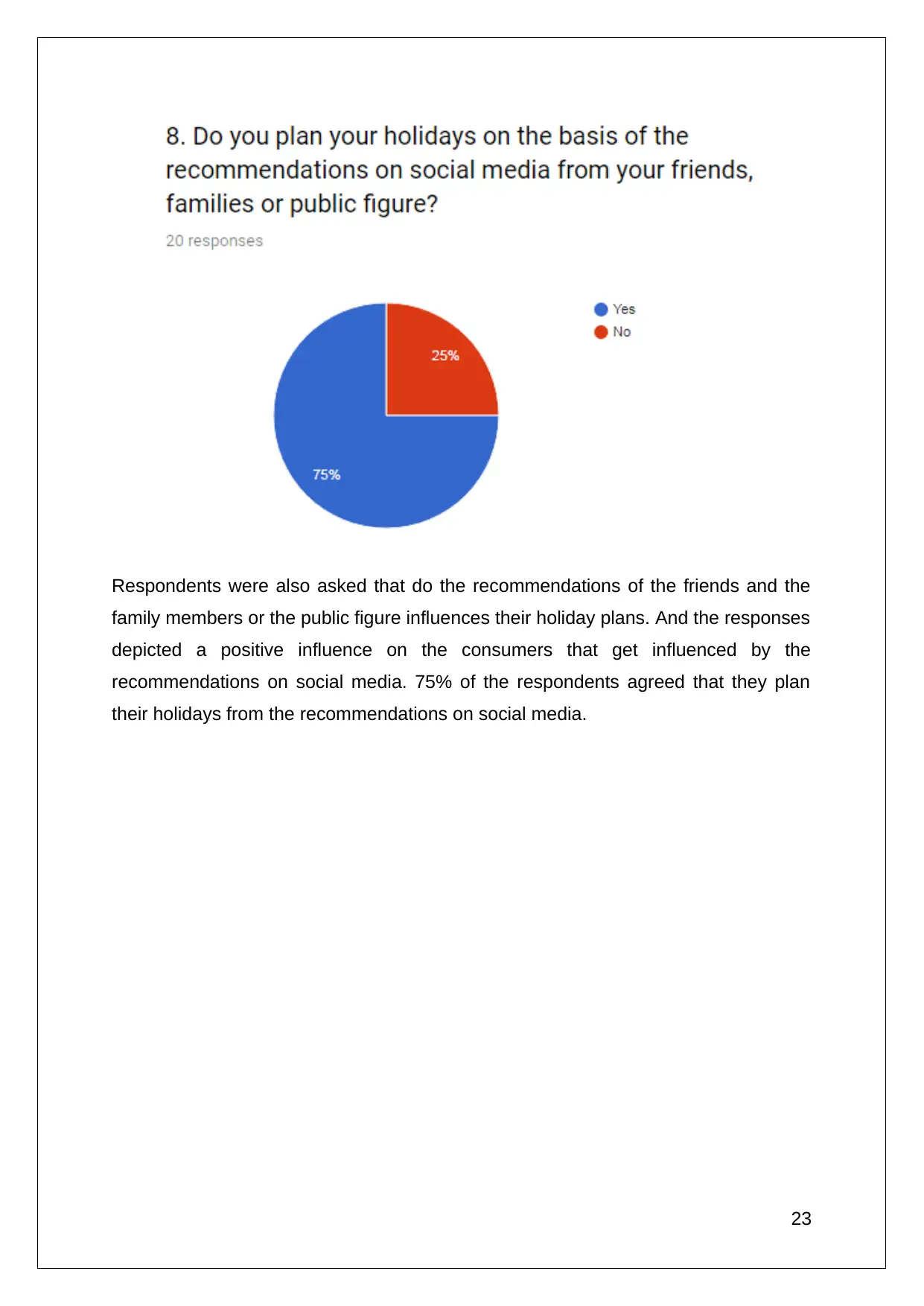
Respondents were also asked that do the recommendations of the friends and the
family members or the public figure influences their holiday plans. And the responses
depicted a positive influence on the consumers that get influenced by the
recommendations on social media. 75% of the respondents agreed that they plan
their holidays from the recommendations on social media.
23
family members or the public figure influences their holiday plans. And the responses
depicted a positive influence on the consumers that get influenced by the
recommendations on social media. 75% of the respondents agreed that they plan
their holidays from the recommendations on social media.
23
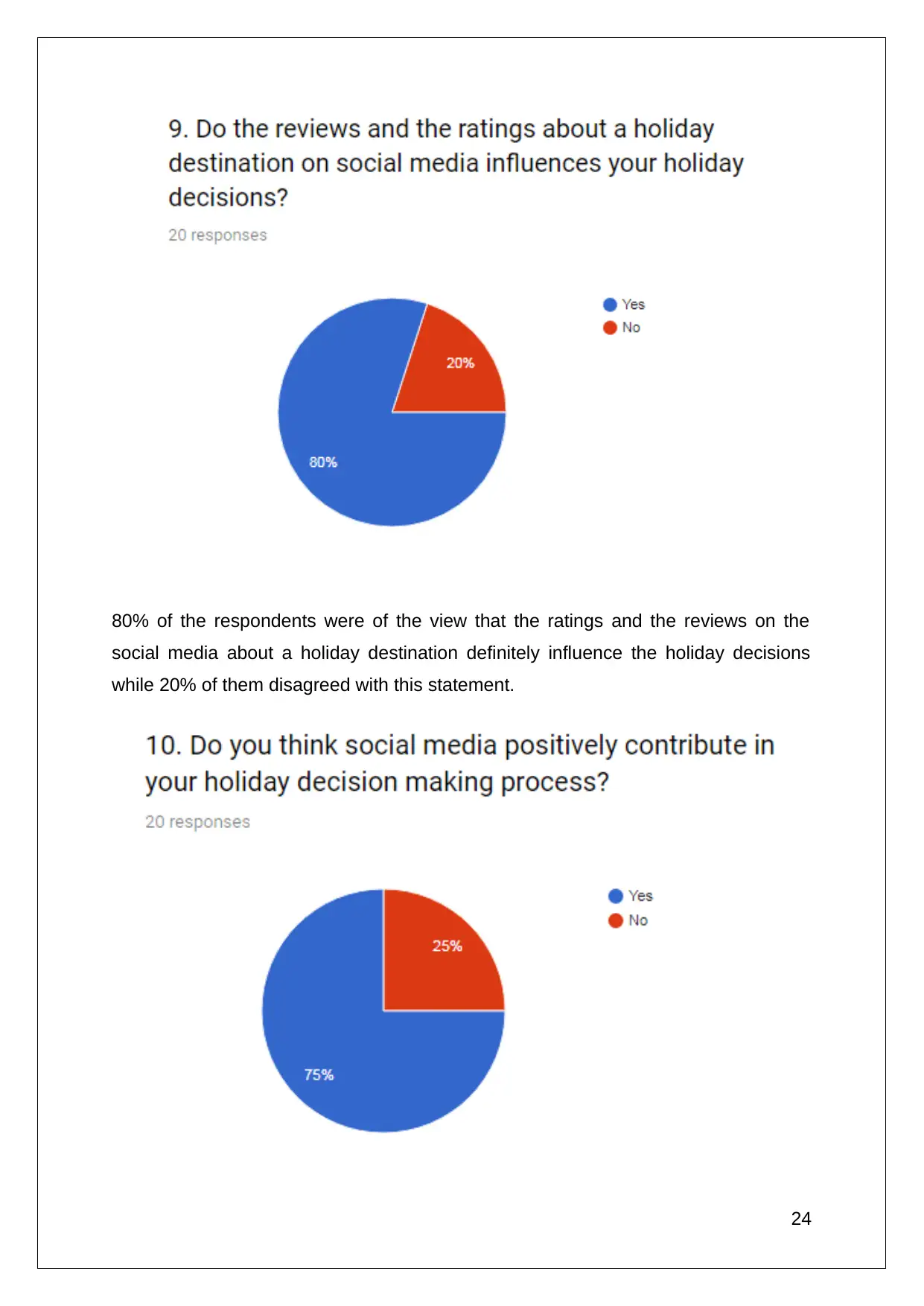
80% of the respondents were of the view that the ratings and the reviews on the
social media about a holiday destination definitely influence the holiday decisions
while 20% of them disagreed with this statement.
24
social media about a holiday destination definitely influence the holiday decisions
while 20% of them disagreed with this statement.
24

Lastly, respondents were asked about the contribution of the social media in their
decision-making process of the holiday in the travel and tourism sector. And the
result that drawn out was that nearly 75% of the responses were supportive to this
statement that social media positively influences the decision-making process while
other 25% of the respondents did not support this statement.
25
decision-making process of the holiday in the travel and tourism sector. And the
result that drawn out was that nearly 75% of the responses were supportive to this
statement that social media positively influences the decision-making process while
other 25% of the respondents did not support this statement.
25
Paraphrase This Document
Need a fresh take? Get an instant paraphrase of this document with our AI Paraphraser

TASK 3
In this task, the appropriate evaluation techniques and methodology used will be
evaluated which will help to derive the actual results of the research. Through the
recommendations, the conclusions and the findings of the research will help to solve
the research problems.
3.1 EVALUATION OF OUTCOMES
According to the research conducted on the influence of the social media on the
consumer’s holiday decision making process in the travel and tourism sector the
data that was collected will be evaluated on the basis of the research outcomes
(Tuten and Solomon, 2017). The findings of the research were such that the social
media has emerged as an influential factor that influences the consumer decision-
making process while holiday planning by the travellers. Through the reviews,
comments, shares, tags, check-in and the photographs of a holiday spot or
destination influences the decisions of the consumers.
Through this overall research project implementation undertaken it came to notice
that the research project was successfully implemented. As the budget, time and the
resources constraint was duly considered and effectively utilised which helped to
reach at a valid conclusion that social media renders a positive influence on the
consumer's holiday decision making process in the travel and tourism sector (Wang
and Yu, 2017).
The research was conducted according to the planned timescale and the resources
were also duly employed as required. Research delivered the desired outcomes and
the findings that too on desired deadlines. In the research project, some of the
difficulties that accomplished included the time and the financial constraints. As there
was less time to complete this research project the data collected may be misleading
and the lead to some mistakes (Zeng and Gerritsen, 2014). And on another ha,nd
there was finance constraint as there was lack of financial sources so the human
resource can be less hired to carry this survey and thus utilised the online survey
method. Due to the time scarcity, the respondents also may have presented biased
or untrue responses which might have led to the misleading results and findings
(Zeng and Gerritsen, 2014).
26
In this task, the appropriate evaluation techniques and methodology used will be
evaluated which will help to derive the actual results of the research. Through the
recommendations, the conclusions and the findings of the research will help to solve
the research problems.
3.1 EVALUATION OF OUTCOMES
According to the research conducted on the influence of the social media on the
consumer’s holiday decision making process in the travel and tourism sector the
data that was collected will be evaluated on the basis of the research outcomes
(Tuten and Solomon, 2017). The findings of the research were such that the social
media has emerged as an influential factor that influences the consumer decision-
making process while holiday planning by the travellers. Through the reviews,
comments, shares, tags, check-in and the photographs of a holiday spot or
destination influences the decisions of the consumers.
Through this overall research project implementation undertaken it came to notice
that the research project was successfully implemented. As the budget, time and the
resources constraint was duly considered and effectively utilised which helped to
reach at a valid conclusion that social media renders a positive influence on the
consumer's holiday decision making process in the travel and tourism sector (Wang
and Yu, 2017).
The research was conducted according to the planned timescale and the resources
were also duly employed as required. Research delivered the desired outcomes and
the findings that too on desired deadlines. In the research project, some of the
difficulties that accomplished included the time and the financial constraints. As there
was less time to complete this research project the data collected may be misleading
and the lead to some mistakes (Zeng and Gerritsen, 2014). And on another ha,nd
there was finance constraint as there was lack of financial sources so the human
resource can be less hired to carry this survey and thus utilised the online survey
method. Due to the time scarcity, the respondents also may have presented biased
or untrue responses which might have led to the misleading results and findings
(Zeng and Gerritsen, 2014).
26
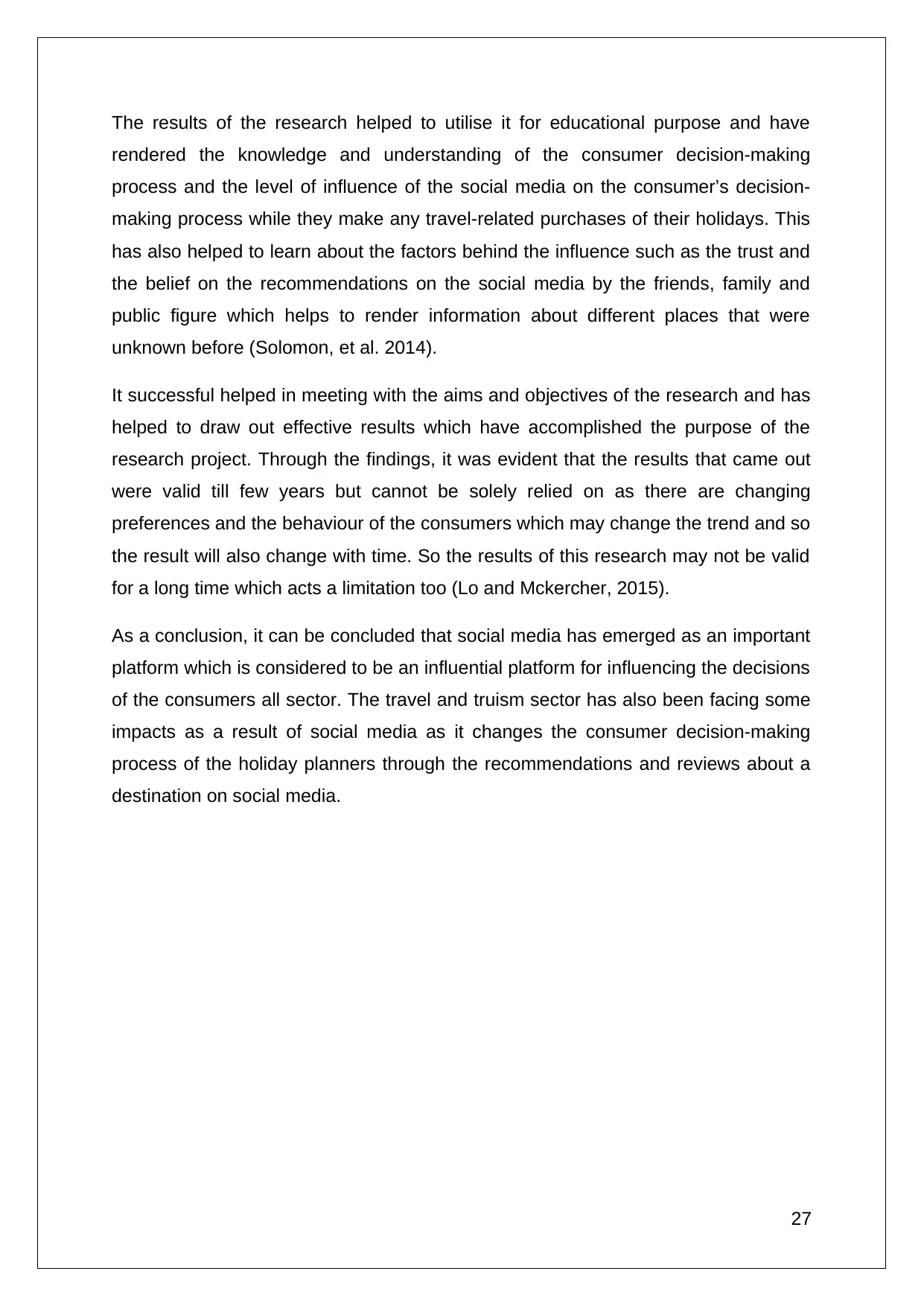
The results of the research helped to utilise it for educational purpose and have
rendered the knowledge and understanding of the consumer decision-making
process and the level of influence of the social media on the consumer’s decision-
making process while they make any travel-related purchases of their holidays. This
has also helped to learn about the factors behind the influence such as the trust and
the belief on the recommendations on the social media by the friends, family and
public figure which helps to render information about different places that were
unknown before (Solomon, et al. 2014).
It successful helped in meeting with the aims and objectives of the research and has
helped to draw out effective results which have accomplished the purpose of the
research project. Through the findings, it was evident that the results that came out
were valid till few years but cannot be solely relied on as there are changing
preferences and the behaviour of the consumers which may change the trend and so
the result will also change with time. So the results of this research may not be valid
for a long time which acts a limitation too (Lo and Mckercher, 2015).
As a conclusion, it can be concluded that social media has emerged as an important
platform which is considered to be an influential platform for influencing the decisions
of the consumers all sector. The travel and truism sector has also been facing some
impacts as a result of social media as it changes the consumer decision-making
process of the holiday planners through the recommendations and reviews about a
destination on social media.
27
rendered the knowledge and understanding of the consumer decision-making
process and the level of influence of the social media on the consumer’s decision-
making process while they make any travel-related purchases of their holidays. This
has also helped to learn about the factors behind the influence such as the trust and
the belief on the recommendations on the social media by the friends, family and
public figure which helps to render information about different places that were
unknown before (Solomon, et al. 2014).
It successful helped in meeting with the aims and objectives of the research and has
helped to draw out effective results which have accomplished the purpose of the
research project. Through the findings, it was evident that the results that came out
were valid till few years but cannot be solely relied on as there are changing
preferences and the behaviour of the consumers which may change the trend and so
the result will also change with time. So the results of this research may not be valid
for a long time which acts a limitation too (Lo and Mckercher, 2015).
As a conclusion, it can be concluded that social media has emerged as an important
platform which is considered to be an influential platform for influencing the decisions
of the consumers all sector. The travel and truism sector has also been facing some
impacts as a result of social media as it changes the consumer decision-making
process of the holiday planners through the recommendations and reviews about a
destination on social media.
27
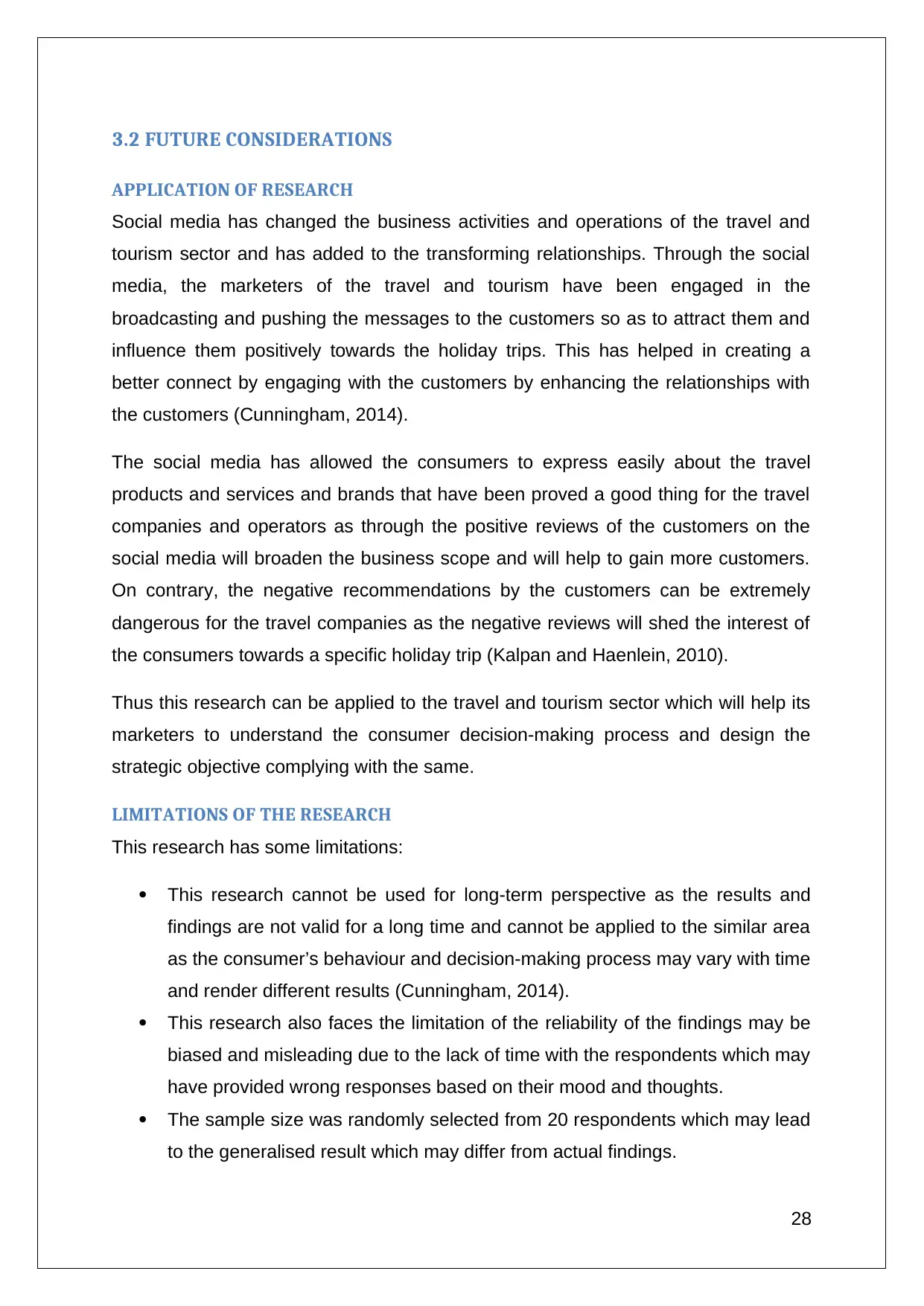
3.2 FUTURE CONSIDERATIONS
APPLICATION OF RESEARCH
Social media has changed the business activities and operations of the travel and
tourism sector and has added to the transforming relationships. Through the social
media, the marketers of the travel and tourism have been engaged in the
broadcasting and pushing the messages to the customers so as to attract them and
influence them positively towards the holiday trips. This has helped in creating a
better connect by engaging with the customers by enhancing the relationships with
the customers (Cunningham, 2014).
The social media has allowed the consumers to express easily about the travel
products and services and brands that have been proved a good thing for the travel
companies and operators as through the positive reviews of the customers on the
social media will broaden the business scope and will help to gain more customers.
On contrary, the negative recommendations by the customers can be extremely
dangerous for the travel companies as the negative reviews will shed the interest of
the consumers towards a specific holiday trip (Kalpan and Haenlein, 2010).
Thus this research can be applied to the travel and tourism sector which will help its
marketers to understand the consumer decision-making process and design the
strategic objective complying with the same.
LIMITATIONS OF THE RESEARCH
This research has some limitations:
This research cannot be used for long-term perspective as the results and
findings are not valid for a long time and cannot be applied to the similar area
as the consumer’s behaviour and decision-making process may vary with time
and render different results (Cunningham, 2014).
This research also faces the limitation of the reliability of the findings may be
biased and misleading due to the lack of time with the respondents which may
have provided wrong responses based on their mood and thoughts.
The sample size was randomly selected from 20 respondents which may lead
to the generalised result which may differ from actual findings.
28
APPLICATION OF RESEARCH
Social media has changed the business activities and operations of the travel and
tourism sector and has added to the transforming relationships. Through the social
media, the marketers of the travel and tourism have been engaged in the
broadcasting and pushing the messages to the customers so as to attract them and
influence them positively towards the holiday trips. This has helped in creating a
better connect by engaging with the customers by enhancing the relationships with
the customers (Cunningham, 2014).
The social media has allowed the consumers to express easily about the travel
products and services and brands that have been proved a good thing for the travel
companies and operators as through the positive reviews of the customers on the
social media will broaden the business scope and will help to gain more customers.
On contrary, the negative recommendations by the customers can be extremely
dangerous for the travel companies as the negative reviews will shed the interest of
the consumers towards a specific holiday trip (Kalpan and Haenlein, 2010).
Thus this research can be applied to the travel and tourism sector which will help its
marketers to understand the consumer decision-making process and design the
strategic objective complying with the same.
LIMITATIONS OF THE RESEARCH
This research has some limitations:
This research cannot be used for long-term perspective as the results and
findings are not valid for a long time and cannot be applied to the similar area
as the consumer’s behaviour and decision-making process may vary with time
and render different results (Cunningham, 2014).
This research also faces the limitation of the reliability of the findings may be
biased and misleading due to the lack of time with the respondents which may
have provided wrong responses based on their mood and thoughts.
The sample size was randomly selected from 20 respondents which may lead
to the generalised result which may differ from actual findings.
28
Secure Best Marks with AI Grader
Need help grading? Try our AI Grader for instant feedback on your assignments.
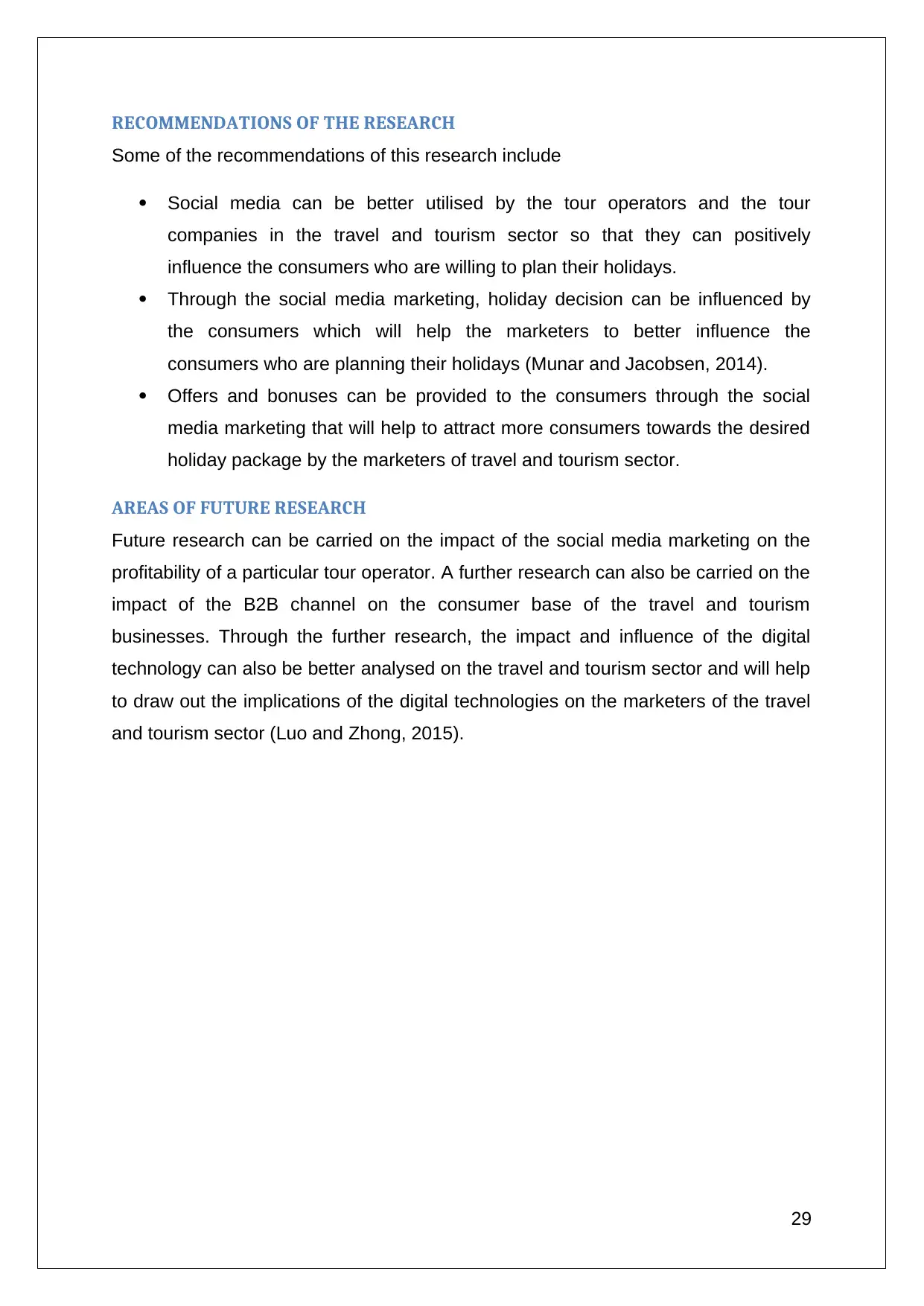
RECOMMENDATIONS OF THE RESEARCH
Some of the recommendations of this research include
Social media can be better utilised by the tour operators and the tour
companies in the travel and tourism sector so that they can positively
influence the consumers who are willing to plan their holidays.
Through the social media marketing, holiday decision can be influenced by
the consumers which will help the marketers to better influence the
consumers who are planning their holidays (Munar and Jacobsen, 2014).
Offers and bonuses can be provided to the consumers through the social
media marketing that will help to attract more consumers towards the desired
holiday package by the marketers of travel and tourism sector.
AREAS OF FUTURE RESEARCH
Future research can be carried on the impact of the social media marketing on the
profitability of a particular tour operator. A further research can also be carried on the
impact of the B2B channel on the consumer base of the travel and tourism
businesses. Through the further research, the impact and influence of the digital
technology can also be better analysed on the travel and tourism sector and will help
to draw out the implications of the digital technologies on the marketers of the travel
and tourism sector (Luo and Zhong, 2015).
29
Some of the recommendations of this research include
Social media can be better utilised by the tour operators and the tour
companies in the travel and tourism sector so that they can positively
influence the consumers who are willing to plan their holidays.
Through the social media marketing, holiday decision can be influenced by
the consumers which will help the marketers to better influence the
consumers who are planning their holidays (Munar and Jacobsen, 2014).
Offers and bonuses can be provided to the consumers through the social
media marketing that will help to attract more consumers towards the desired
holiday package by the marketers of travel and tourism sector.
AREAS OF FUTURE RESEARCH
Future research can be carried on the impact of the social media marketing on the
profitability of a particular tour operator. A further research can also be carried on the
impact of the B2B channel on the consumer base of the travel and tourism
businesses. Through the further research, the impact and influence of the digital
technology can also be better analysed on the travel and tourism sector and will help
to draw out the implications of the digital technologies on the marketers of the travel
and tourism sector (Luo and Zhong, 2015).
29
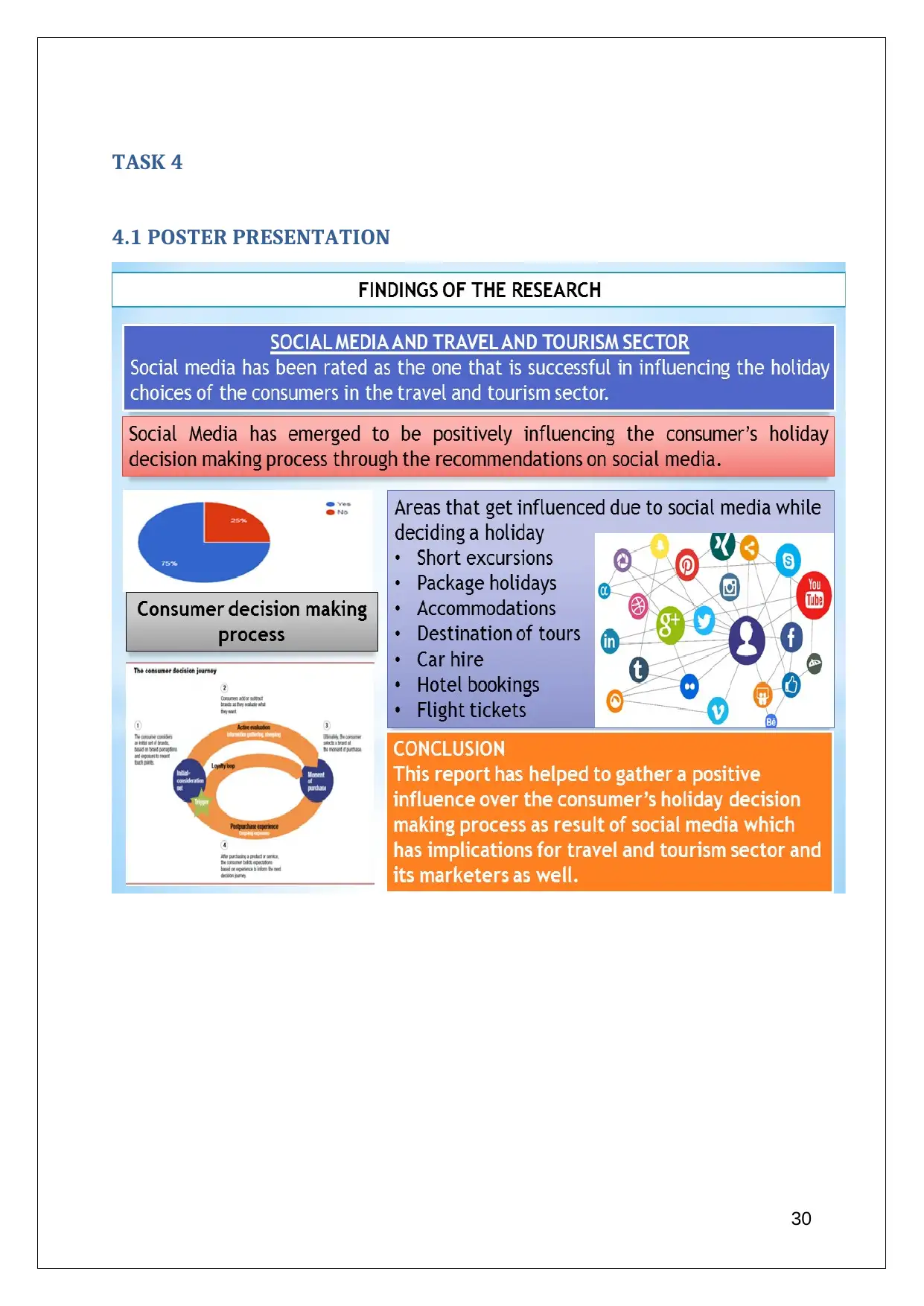
TASK 4
4.1 POSTER PRESENTATION
30
4.1 POSTER PRESENTATION
30
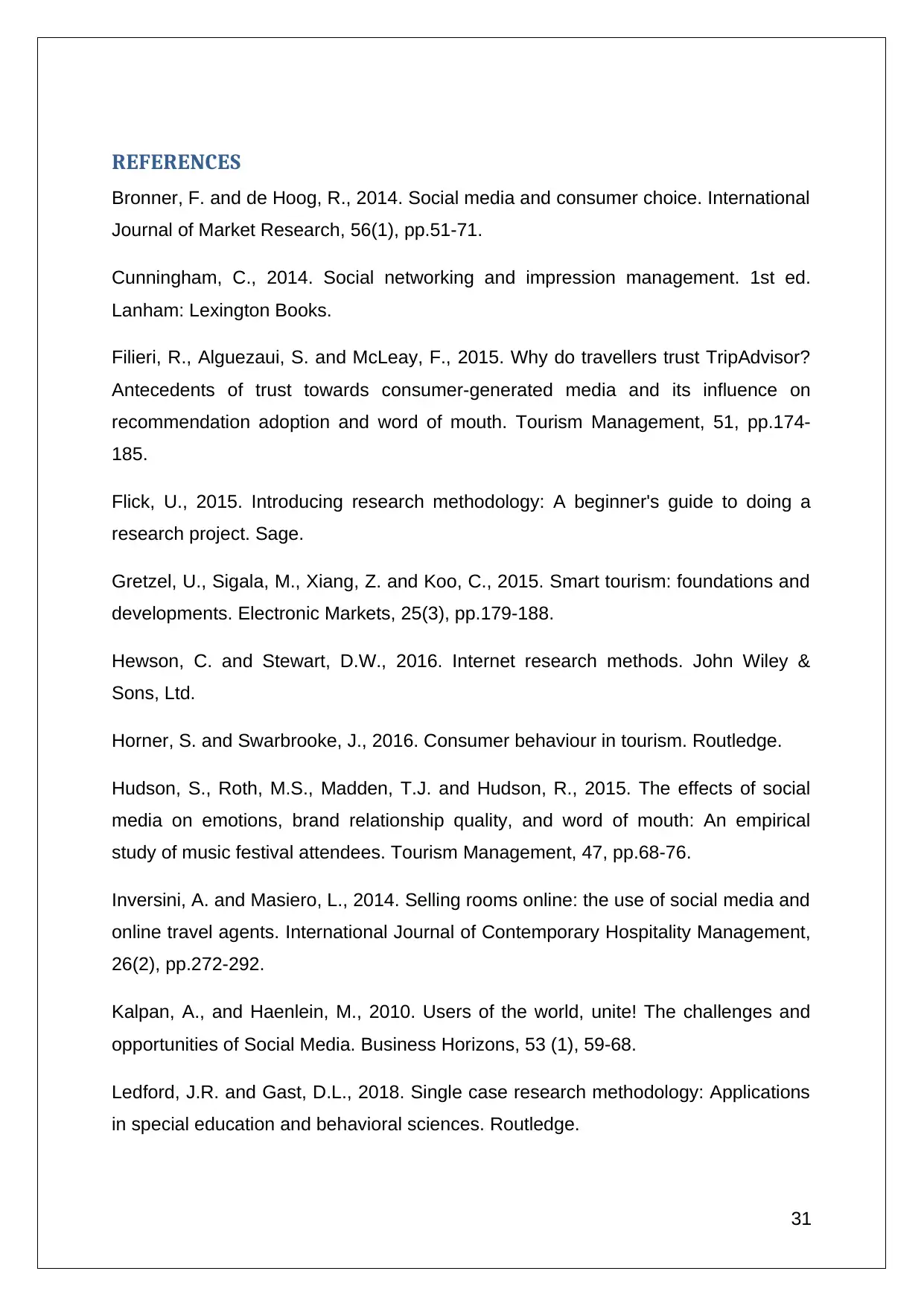
REFERENCES
Bronner, F. and de Hoog, R., 2014. Social media and consumer choice. International
Journal of Market Research, 56(1), pp.51-71.
Cunningham, C., 2014. Social networking and impression management. 1st ed.
Lanham: Lexington Books.
Filieri, R., Alguezaui, S. and McLeay, F., 2015. Why do travellers trust TripAdvisor?
Antecedents of trust towards consumer-generated media and its influence on
recommendation adoption and word of mouth. Tourism Management, 51, pp.174-
185.
Flick, U., 2015. Introducing research methodology: A beginner's guide to doing a
research project. Sage.
Gretzel, U., Sigala, M., Xiang, Z. and Koo, C., 2015. Smart tourism: foundations and
developments. Electronic Markets, 25(3), pp.179-188.
Hewson, C. and Stewart, D.W., 2016. Internet research methods. John Wiley &
Sons, Ltd.
Horner, S. and Swarbrooke, J., 2016. Consumer behaviour in tourism. Routledge.
Hudson, S., Roth, M.S., Madden, T.J. and Hudson, R., 2015. The effects of social
media on emotions, brand relationship quality, and word of mouth: An empirical
study of music festival attendees. Tourism Management, 47, pp.68-76.
Inversini, A. and Masiero, L., 2014. Selling rooms online: the use of social media and
online travel agents. International Journal of Contemporary Hospitality Management,
26(2), pp.272-292.
Kalpan, A., and Haenlein, M., 2010. Users of the world, unite! The challenges and
opportunities of Social Media. Business Horizons, 53 (1), 59-68.
Ledford, J.R. and Gast, D.L., 2018. Single case research methodology: Applications
in special education and behavioral sciences. Routledge.
31
Bronner, F. and de Hoog, R., 2014. Social media and consumer choice. International
Journal of Market Research, 56(1), pp.51-71.
Cunningham, C., 2014. Social networking and impression management. 1st ed.
Lanham: Lexington Books.
Filieri, R., Alguezaui, S. and McLeay, F., 2015. Why do travellers trust TripAdvisor?
Antecedents of trust towards consumer-generated media and its influence on
recommendation adoption and word of mouth. Tourism Management, 51, pp.174-
185.
Flick, U., 2015. Introducing research methodology: A beginner's guide to doing a
research project. Sage.
Gretzel, U., Sigala, M., Xiang, Z. and Koo, C., 2015. Smart tourism: foundations and
developments. Electronic Markets, 25(3), pp.179-188.
Hewson, C. and Stewart, D.W., 2016. Internet research methods. John Wiley &
Sons, Ltd.
Horner, S. and Swarbrooke, J., 2016. Consumer behaviour in tourism. Routledge.
Hudson, S., Roth, M.S., Madden, T.J. and Hudson, R., 2015. The effects of social
media on emotions, brand relationship quality, and word of mouth: An empirical
study of music festival attendees. Tourism Management, 47, pp.68-76.
Inversini, A. and Masiero, L., 2014. Selling rooms online: the use of social media and
online travel agents. International Journal of Contemporary Hospitality Management,
26(2), pp.272-292.
Kalpan, A., and Haenlein, M., 2010. Users of the world, unite! The challenges and
opportunities of Social Media. Business Horizons, 53 (1), 59-68.
Ledford, J.R. and Gast, D.L., 2018. Single case research methodology: Applications
in special education and behavioral sciences. Routledge.
31
Paraphrase This Document
Need a fresh take? Get an instant paraphrase of this document with our AI Paraphraser
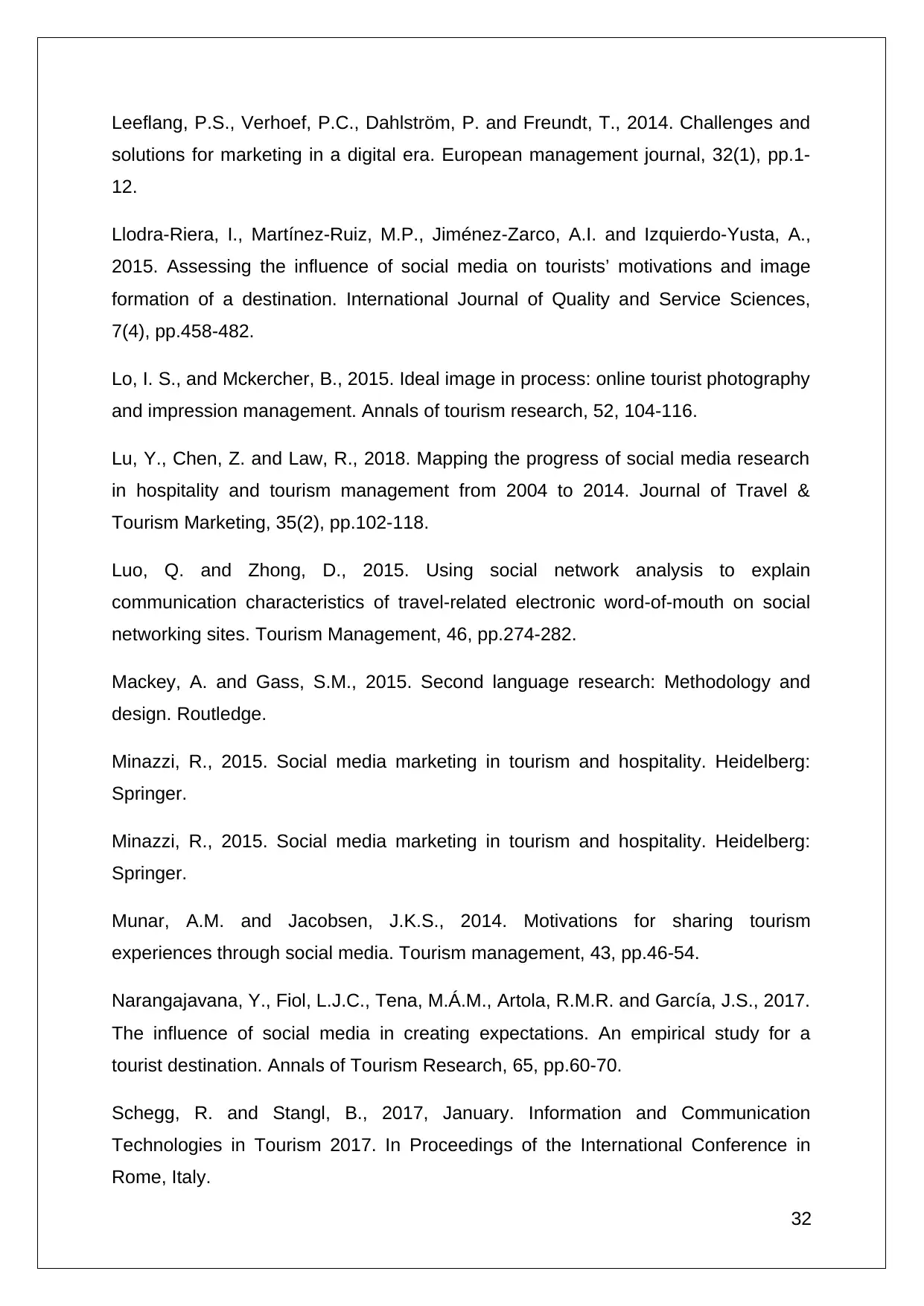
Leeflang, P.S., Verhoef, P.C., Dahlström, P. and Freundt, T., 2014. Challenges and
solutions for marketing in a digital era. European management journal, 32(1), pp.1-
12.
Llodra-Riera, I., Martínez-Ruiz, M.P., Jiménez-Zarco, A.I. and Izquierdo-Yusta, A.,
2015. Assessing the influence of social media on tourists’ motivations and image
formation of a destination. International Journal of Quality and Service Sciences,
7(4), pp.458-482.
Lo, I. S., and Mckercher, B., 2015. Ideal image in process: online tourist photography
and impression management. Annals of tourism research, 52, 104-116.
Lu, Y., Chen, Z. and Law, R., 2018. Mapping the progress of social media research
in hospitality and tourism management from 2004 to 2014. Journal of Travel &
Tourism Marketing, 35(2), pp.102-118.
Luo, Q. and Zhong, D., 2015. Using social network analysis to explain
communication characteristics of travel-related electronic word-of-mouth on social
networking sites. Tourism Management, 46, pp.274-282.
Mackey, A. and Gass, S.M., 2015. Second language research: Methodology and
design. Routledge.
Minazzi, R., 2015. Social media marketing in tourism and hospitality. Heidelberg:
Springer.
Minazzi, R., 2015. Social media marketing in tourism and hospitality. Heidelberg:
Springer.
Munar, A.M. and Jacobsen, J.K.S., 2014. Motivations for sharing tourism
experiences through social media. Tourism management, 43, pp.46-54.
Narangajavana, Y., Fiol, L.J.C., Tena, M.Á.M., Artola, R.M.R. and García, J.S., 2017.
The influence of social media in creating expectations. An empirical study for a
tourist destination. Annals of Tourism Research, 65, pp.60-70.
Schegg, R. and Stangl, B., 2017, January. Information and Communication
Technologies in Tourism 2017. In Proceedings of the International Conference in
Rome, Italy.
32
solutions for marketing in a digital era. European management journal, 32(1), pp.1-
12.
Llodra-Riera, I., Martínez-Ruiz, M.P., Jiménez-Zarco, A.I. and Izquierdo-Yusta, A.,
2015. Assessing the influence of social media on tourists’ motivations and image
formation of a destination. International Journal of Quality and Service Sciences,
7(4), pp.458-482.
Lo, I. S., and Mckercher, B., 2015. Ideal image in process: online tourist photography
and impression management. Annals of tourism research, 52, 104-116.
Lu, Y., Chen, Z. and Law, R., 2018. Mapping the progress of social media research
in hospitality and tourism management from 2004 to 2014. Journal of Travel &
Tourism Marketing, 35(2), pp.102-118.
Luo, Q. and Zhong, D., 2015. Using social network analysis to explain
communication characteristics of travel-related electronic word-of-mouth on social
networking sites. Tourism Management, 46, pp.274-282.
Mackey, A. and Gass, S.M., 2015. Second language research: Methodology and
design. Routledge.
Minazzi, R., 2015. Social media marketing in tourism and hospitality. Heidelberg:
Springer.
Minazzi, R., 2015. Social media marketing in tourism and hospitality. Heidelberg:
Springer.
Munar, A.M. and Jacobsen, J.K.S., 2014. Motivations for sharing tourism
experiences through social media. Tourism management, 43, pp.46-54.
Narangajavana, Y., Fiol, L.J.C., Tena, M.Á.M., Artola, R.M.R. and García, J.S., 2017.
The influence of social media in creating expectations. An empirical study for a
tourist destination. Annals of Tourism Research, 65, pp.60-70.
Schegg, R. and Stangl, B., 2017, January. Information and Communication
Technologies in Tourism 2017. In Proceedings of the International Conference in
Rome, Italy.
32
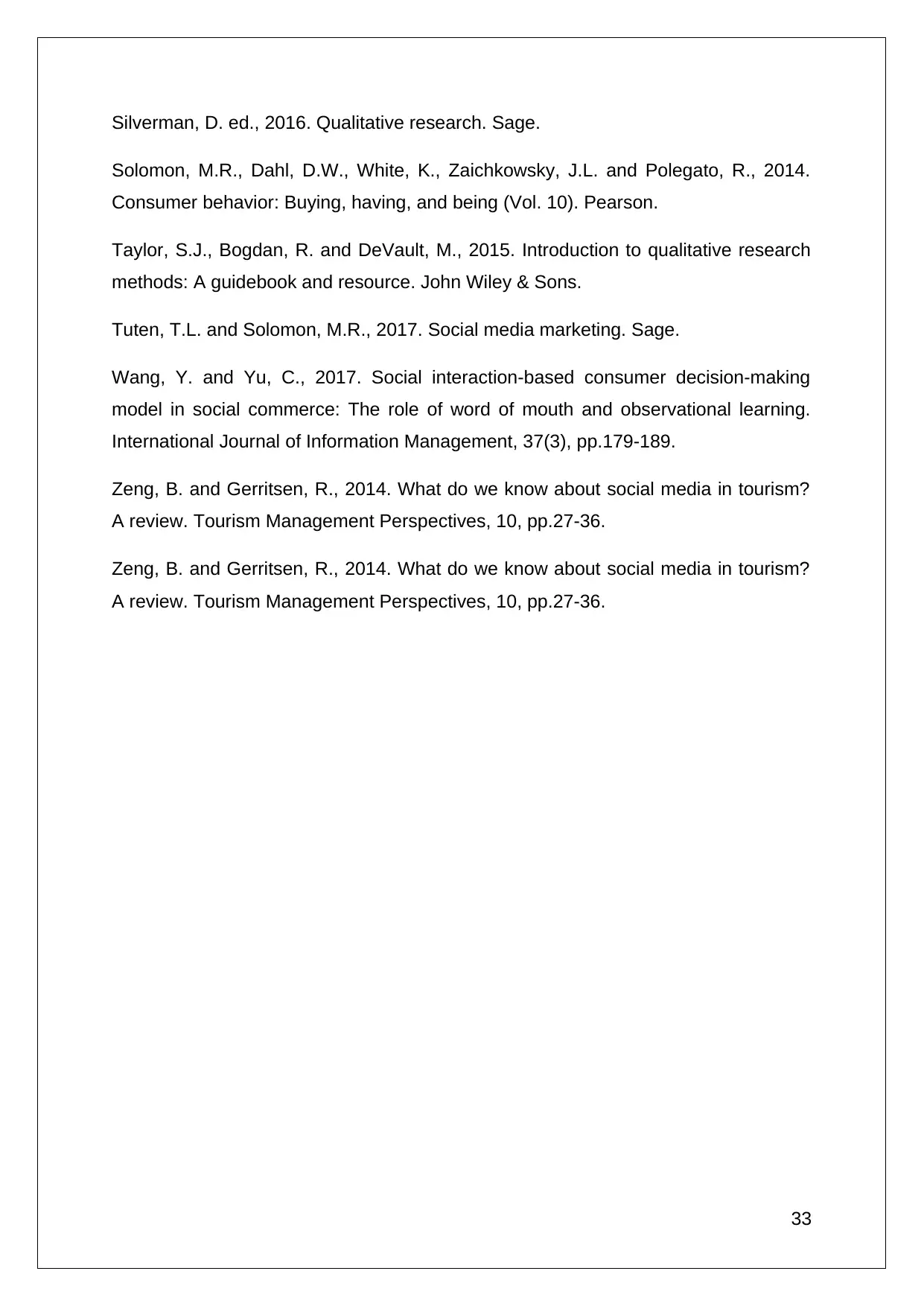
Silverman, D. ed., 2016. Qualitative research. Sage.
Solomon, M.R., Dahl, D.W., White, K., Zaichkowsky, J.L. and Polegato, R., 2014.
Consumer behavior: Buying, having, and being (Vol. 10). Pearson.
Taylor, S.J., Bogdan, R. and DeVault, M., 2015. Introduction to qualitative research
methods: A guidebook and resource. John Wiley & Sons.
Tuten, T.L. and Solomon, M.R., 2017. Social media marketing. Sage.
Wang, Y. and Yu, C., 2017. Social interaction-based consumer decision-making
model in social commerce: The role of word of mouth and observational learning.
International Journal of Information Management, 37(3), pp.179-189.
Zeng, B. and Gerritsen, R., 2014. What do we know about social media in tourism?
A review. Tourism Management Perspectives, 10, pp.27-36.
Zeng, B. and Gerritsen, R., 2014. What do we know about social media in tourism?
A review. Tourism Management Perspectives, 10, pp.27-36.
33
Solomon, M.R., Dahl, D.W., White, K., Zaichkowsky, J.L. and Polegato, R., 2014.
Consumer behavior: Buying, having, and being (Vol. 10). Pearson.
Taylor, S.J., Bogdan, R. and DeVault, M., 2015. Introduction to qualitative research
methods: A guidebook and resource. John Wiley & Sons.
Tuten, T.L. and Solomon, M.R., 2017. Social media marketing. Sage.
Wang, Y. and Yu, C., 2017. Social interaction-based consumer decision-making
model in social commerce: The role of word of mouth and observational learning.
International Journal of Information Management, 37(3), pp.179-189.
Zeng, B. and Gerritsen, R., 2014. What do we know about social media in tourism?
A review. Tourism Management Perspectives, 10, pp.27-36.
Zeng, B. and Gerritsen, R., 2014. What do we know about social media in tourism?
A review. Tourism Management Perspectives, 10, pp.27-36.
33
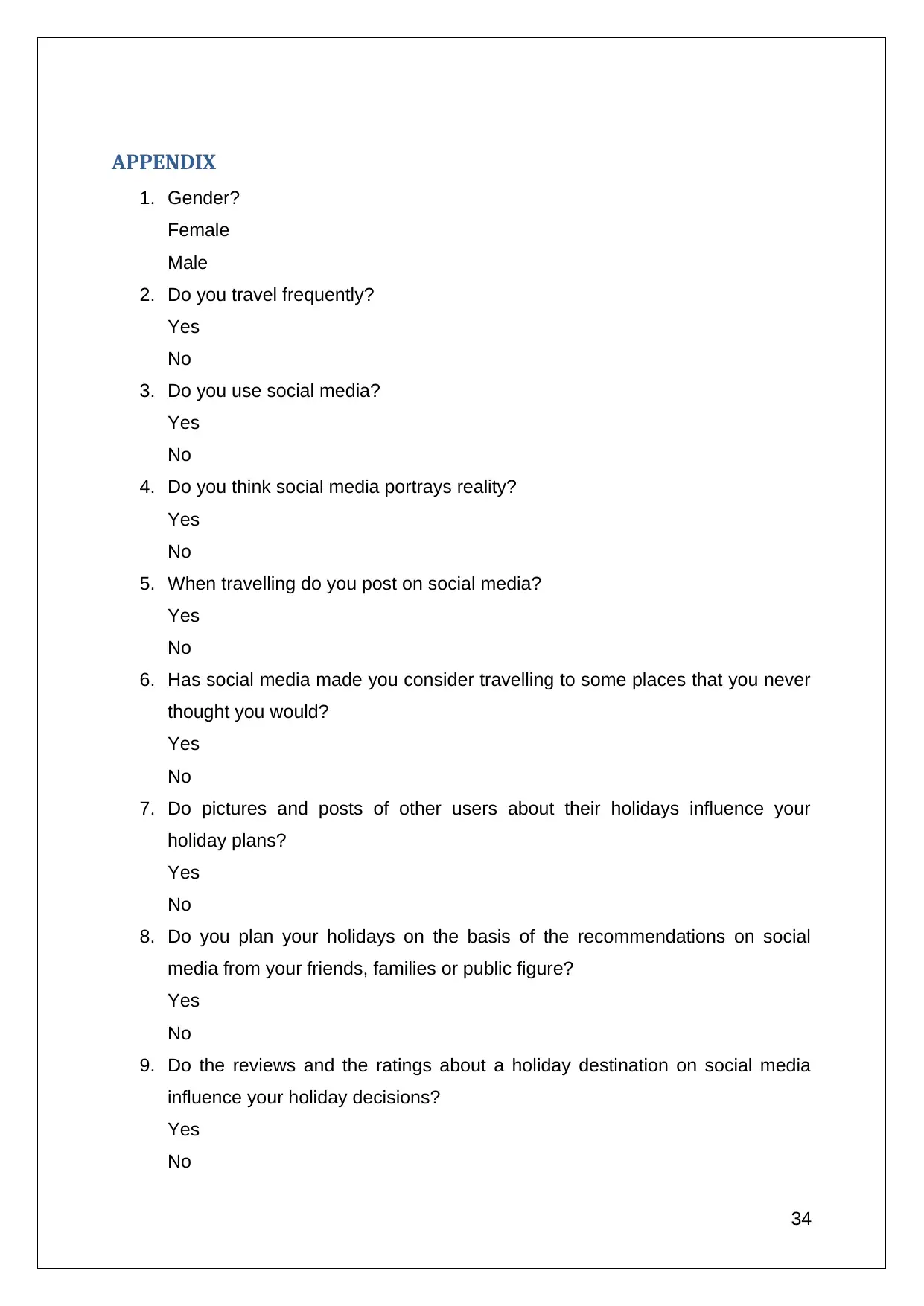
APPENDIX
1. Gender?
Female
Male
2. Do you travel frequently?
Yes
No
3. Do you use social media?
Yes
No
4. Do you think social media portrays reality?
Yes
No
5. When travelling do you post on social media?
Yes
No
6. Has social media made you consider travelling to some places that you never
thought you would?
Yes
No
7. Do pictures and posts of other users about their holidays influence your
holiday plans?
Yes
No
8. Do you plan your holidays on the basis of the recommendations on social
media from your friends, families or public figure?
Yes
No
9. Do the reviews and the ratings about a holiday destination on social media
influence your holiday decisions?
Yes
No
34
1. Gender?
Female
Male
2. Do you travel frequently?
Yes
No
3. Do you use social media?
Yes
No
4. Do you think social media portrays reality?
Yes
No
5. When travelling do you post on social media?
Yes
No
6. Has social media made you consider travelling to some places that you never
thought you would?
Yes
No
7. Do pictures and posts of other users about their holidays influence your
holiday plans?
Yes
No
8. Do you plan your holidays on the basis of the recommendations on social
media from your friends, families or public figure?
Yes
No
9. Do the reviews and the ratings about a holiday destination on social media
influence your holiday decisions?
Yes
No
34
Secure Best Marks with AI Grader
Need help grading? Try our AI Grader for instant feedback on your assignments.
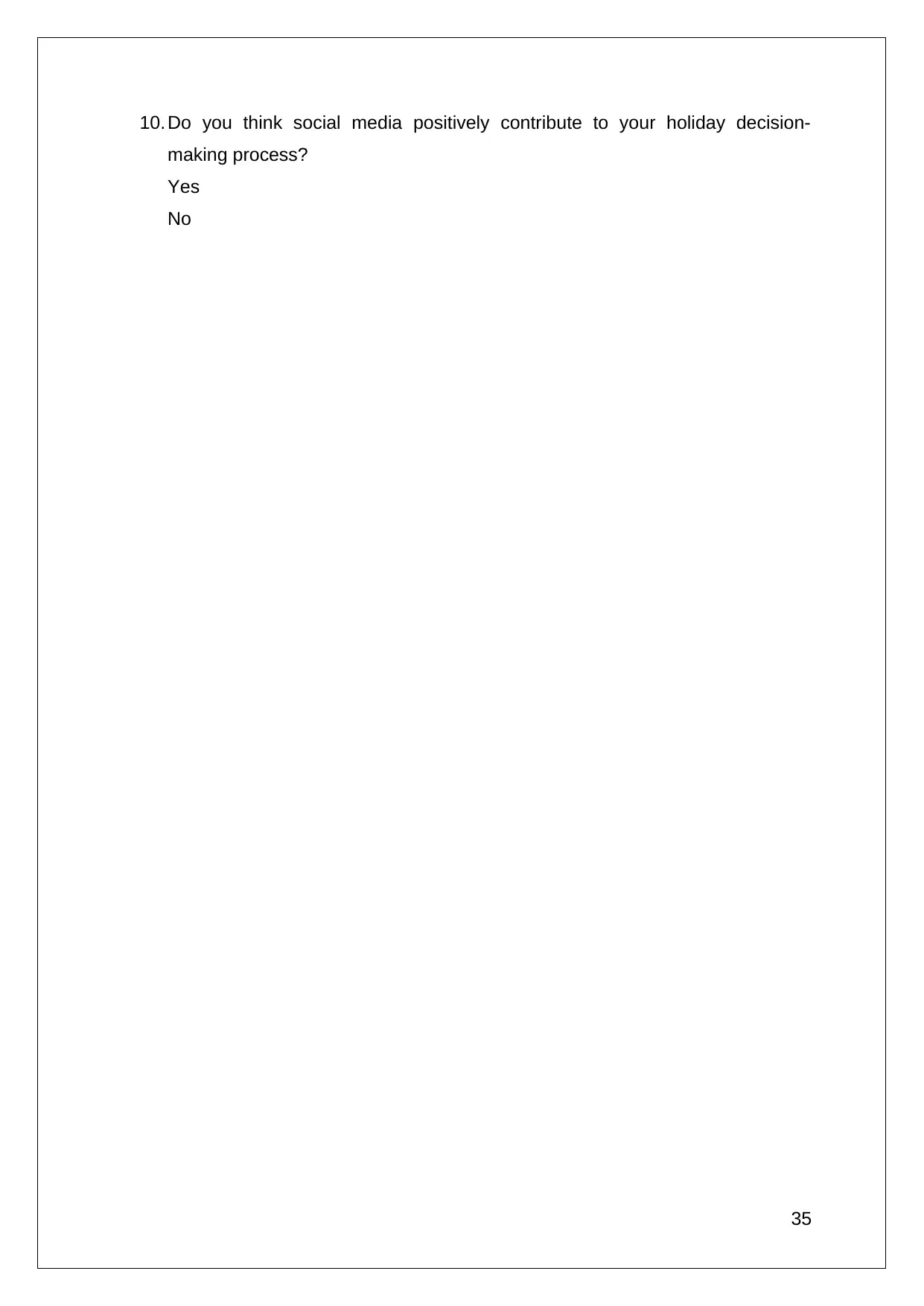
10. Do you think social media positively contribute to your holiday decision-
making process?
Yes
No
35
making process?
Yes
No
35
1 out of 35
Related Documents
Your All-in-One AI-Powered Toolkit for Academic Success.
+13062052269
info@desklib.com
Available 24*7 on WhatsApp / Email
![[object Object]](/_next/static/media/star-bottom.7253800d.svg)
Unlock your academic potential
© 2024 | Zucol Services PVT LTD | All rights reserved.





